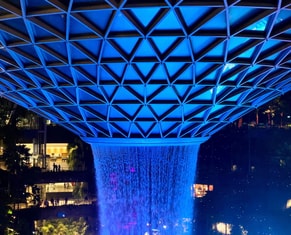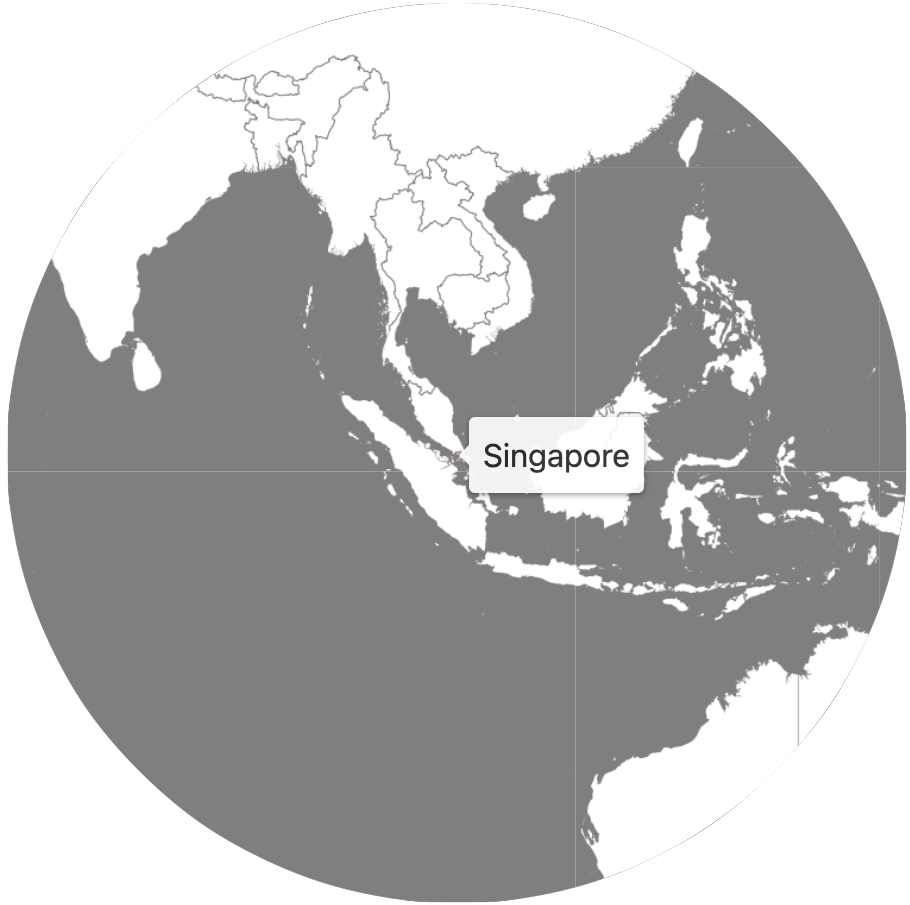
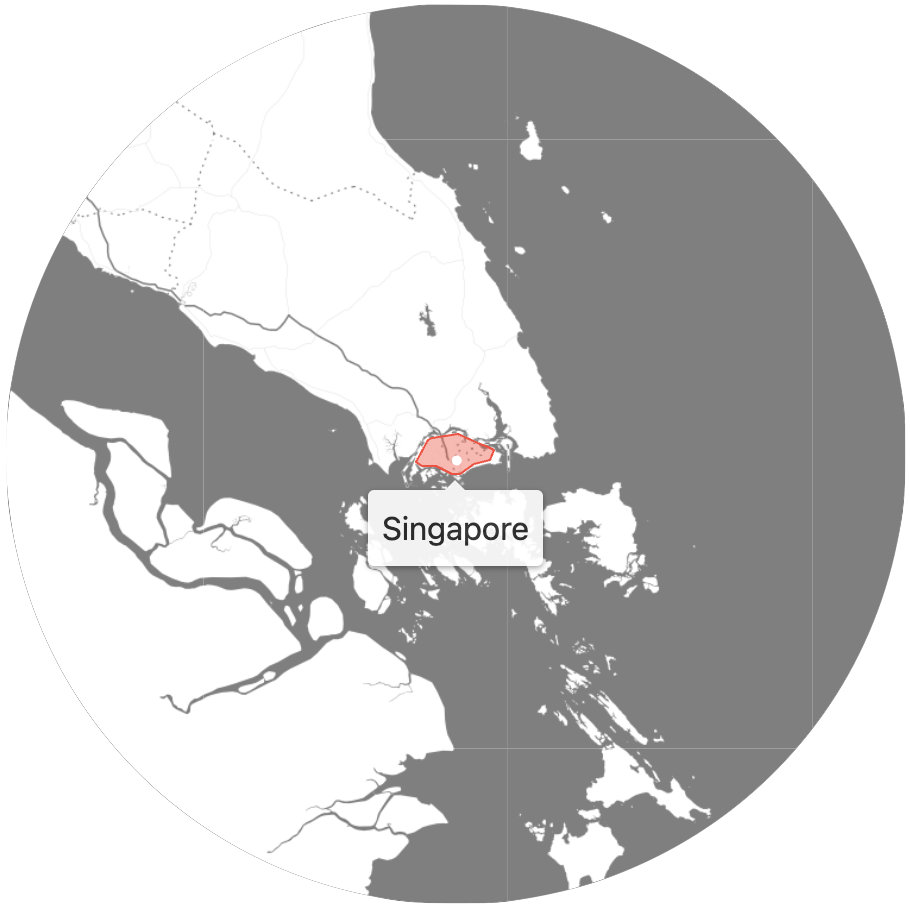

Singapore
It is very tempting to try to poke holes in Singapore’s narrative of itself as a tiny utopia.
Singapore is a city-state on the tip of Malaysia. Home to Crazy Rich Asians, plus temporary migrant workers from surrounding poorer countries.01 Ethnically Chinese (75%), Malay, and Indian, but with a big spoonful of British culture mixed in from its colonialism. Has grown a distinctive English accent, lah. Described by someone we met as a fine country: they love to fine you. Pumps out deeply unfathomable volumes of air conditioning. Everyone I was introduced to was either a doctor or a lawyer or a child. And it is maybe the best food hub on planet earth.
Singapore is microscopic. This makes it all the more surprising when you visit and find spaces that are vast and luxurious, tastefully designed to both feel large but not look gaudy in scale.
For example, the mall attached to one of the airport terminals is humbly called Jewel.02 It alone is packed with a selection of clothes and electronics and restaurants that exceeds the selection of most cities. Oh, and it happens to have the largest indoor waterfall in the world.
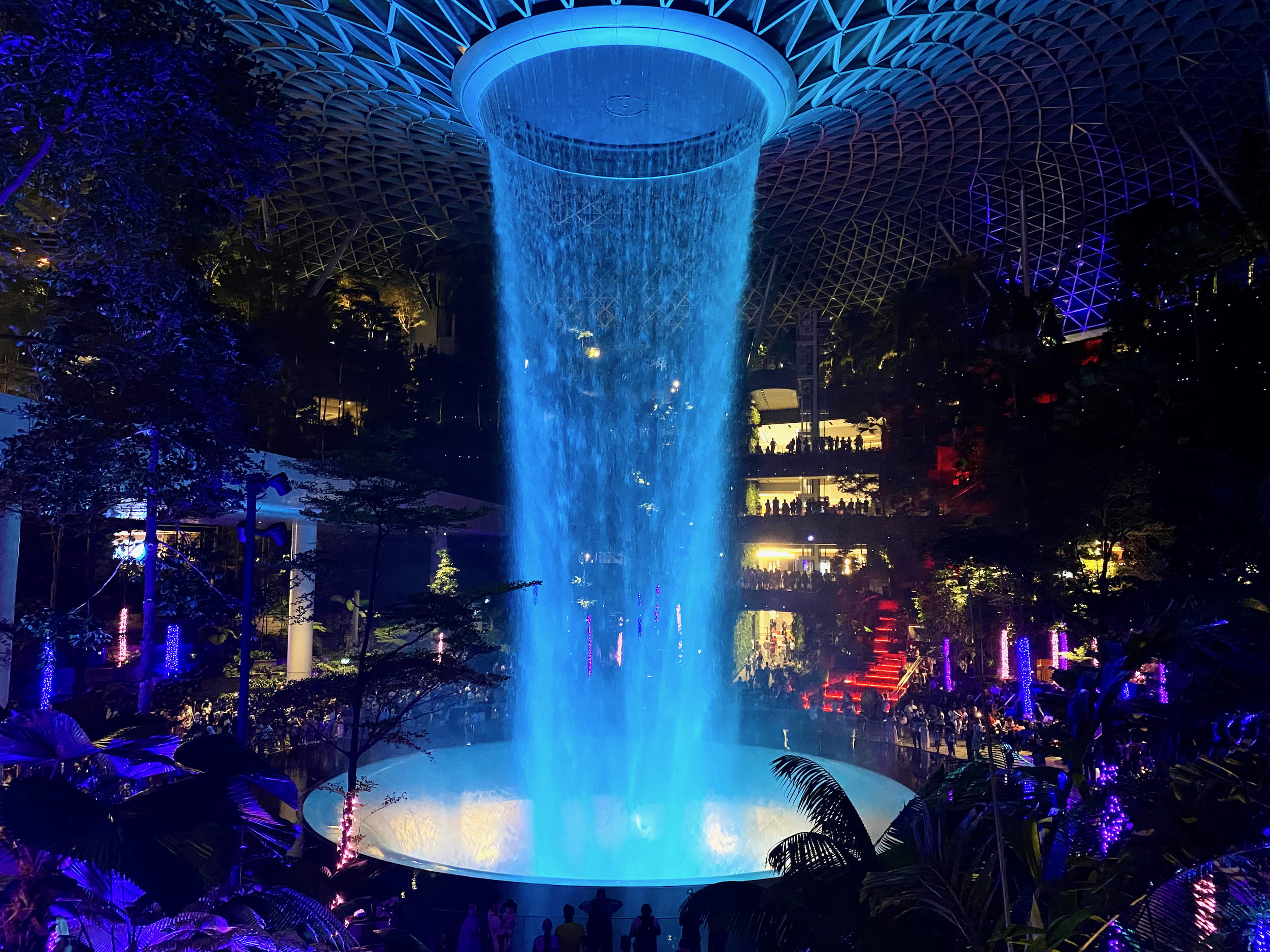
The whole thing is air conditioned, which somehow feels more surprising given the amount of controlled jungle and waterfall inside. There’s also a train running through it, a whole tree fort canopy play area at the top, and… well, you get the picture.
But the surprising thing is that it feels pleasantly large, but doesn’t look gigantic. It is maybe the polar opposite of brutalist design, which—though I’m a fan of brutalism in sort of the way you’d be a fan of cult classic movies—looks ugly in its chonkiness, and then inside often feels claustrophobic. Jewel is delightful to hang out in. (Though, because of the optics, this is tough to convey via photo.)
Let’s take a peak at the oceanfront, and we’ll visit more examples of them pulling off the same thing.
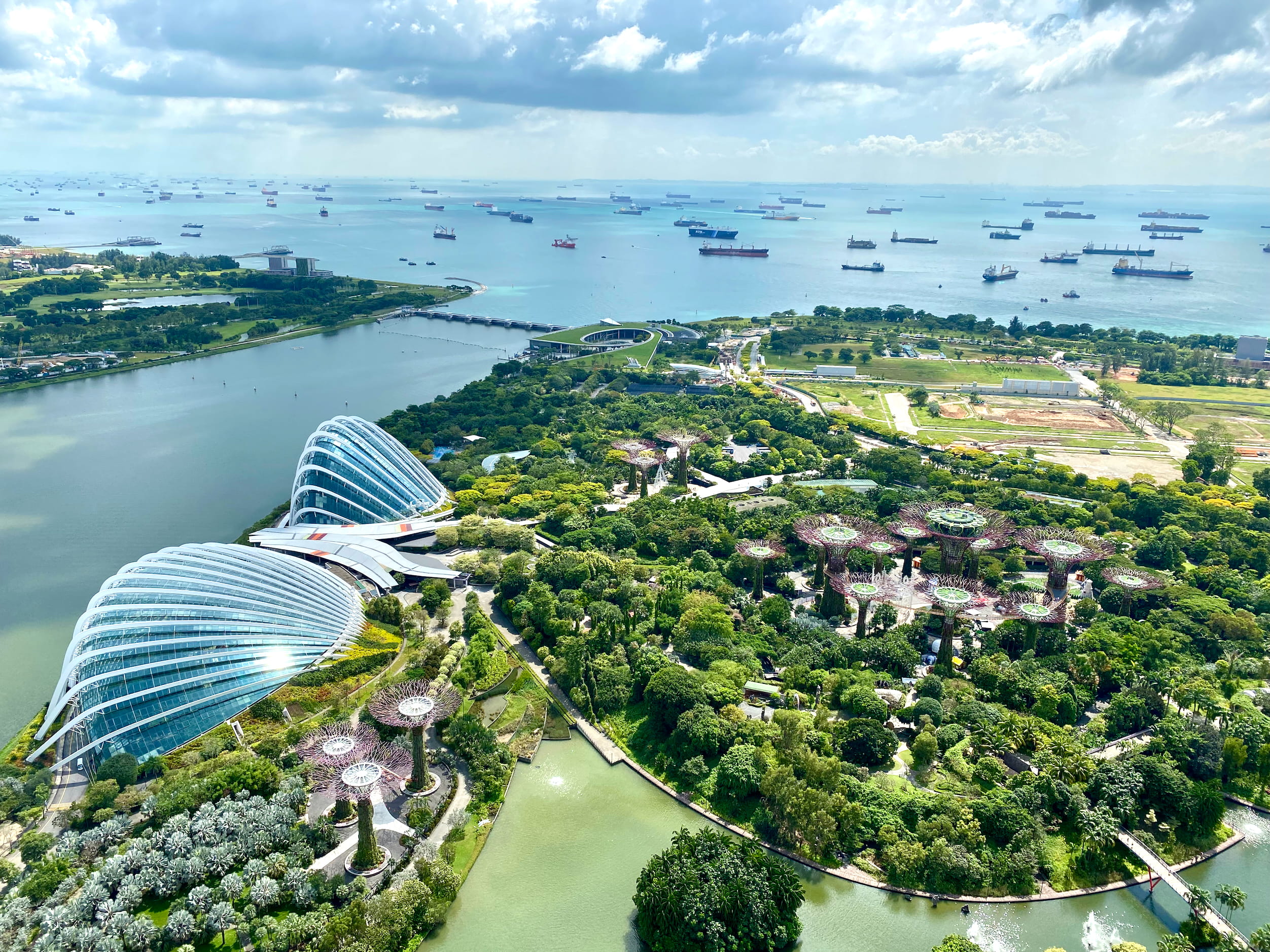
Also note the wild number of ships waiting out at sea.
There are two main things to visit in the waterfront green zone. The first is the park that combines trees with big man-made towers that have plants growing up it to become kind of metal/nature hybrid.
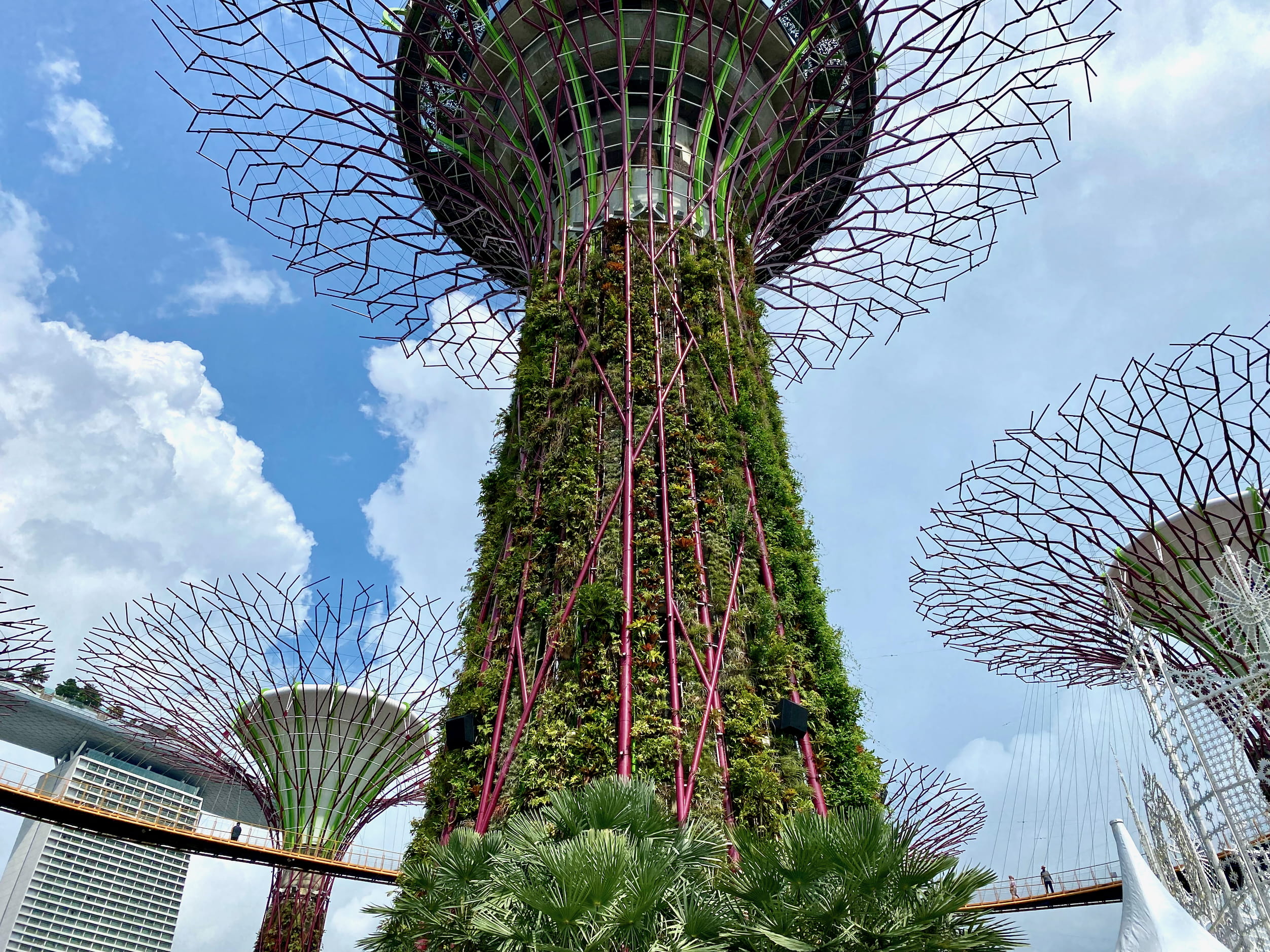
Complete with suspended walkway to check them out from (at extra charge). The visual motif of these wide, sloping, inverted cones is nearly identical to the shape of Jewel’s indoor waterfall.
The second are the pair of glass domes that house botanical gardens, the inside of which is entirely air conditioned. This, again, sounds only kind of impressive, until you’re inside and comprehend its sheer ridiculous scale.
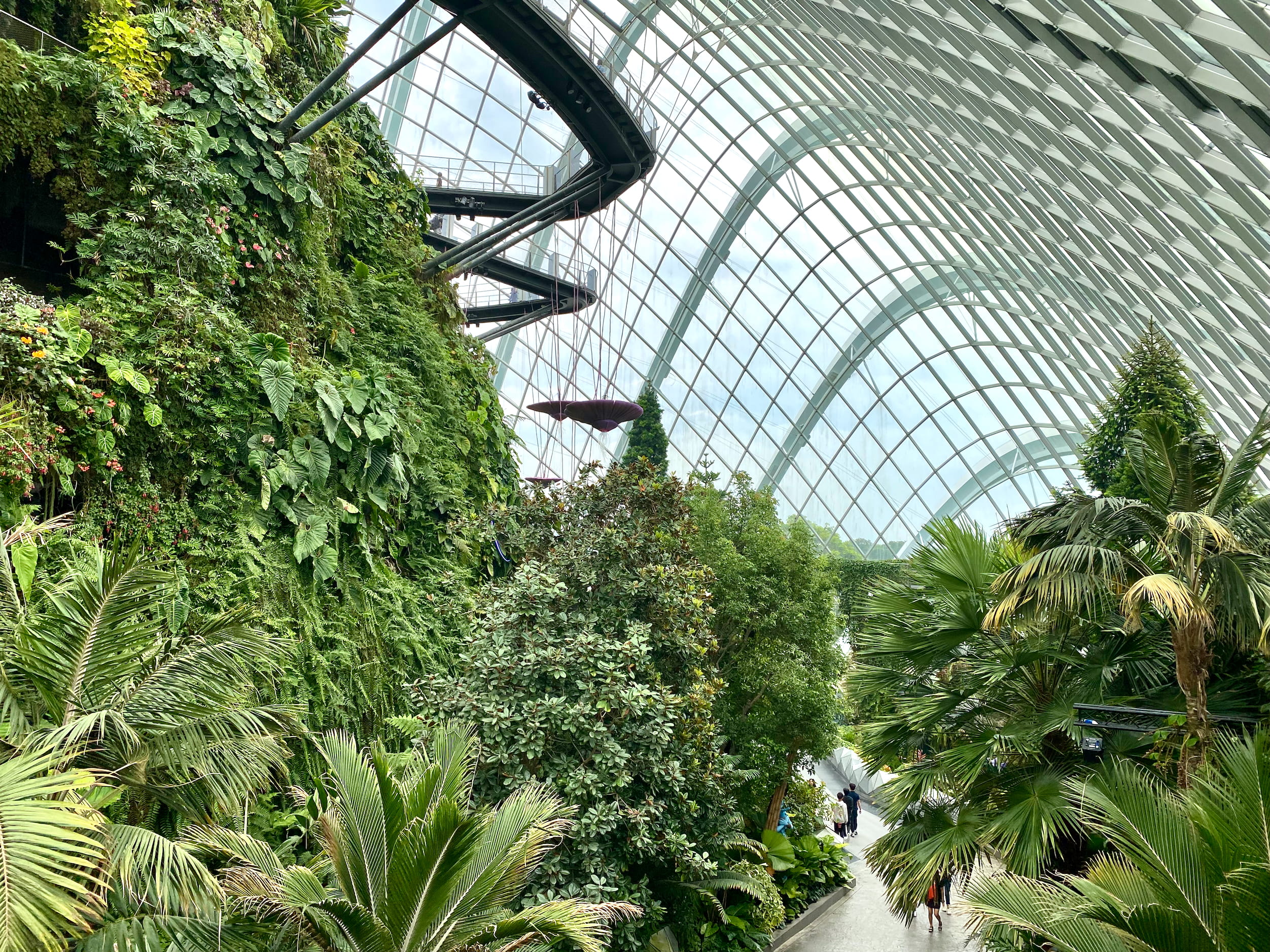
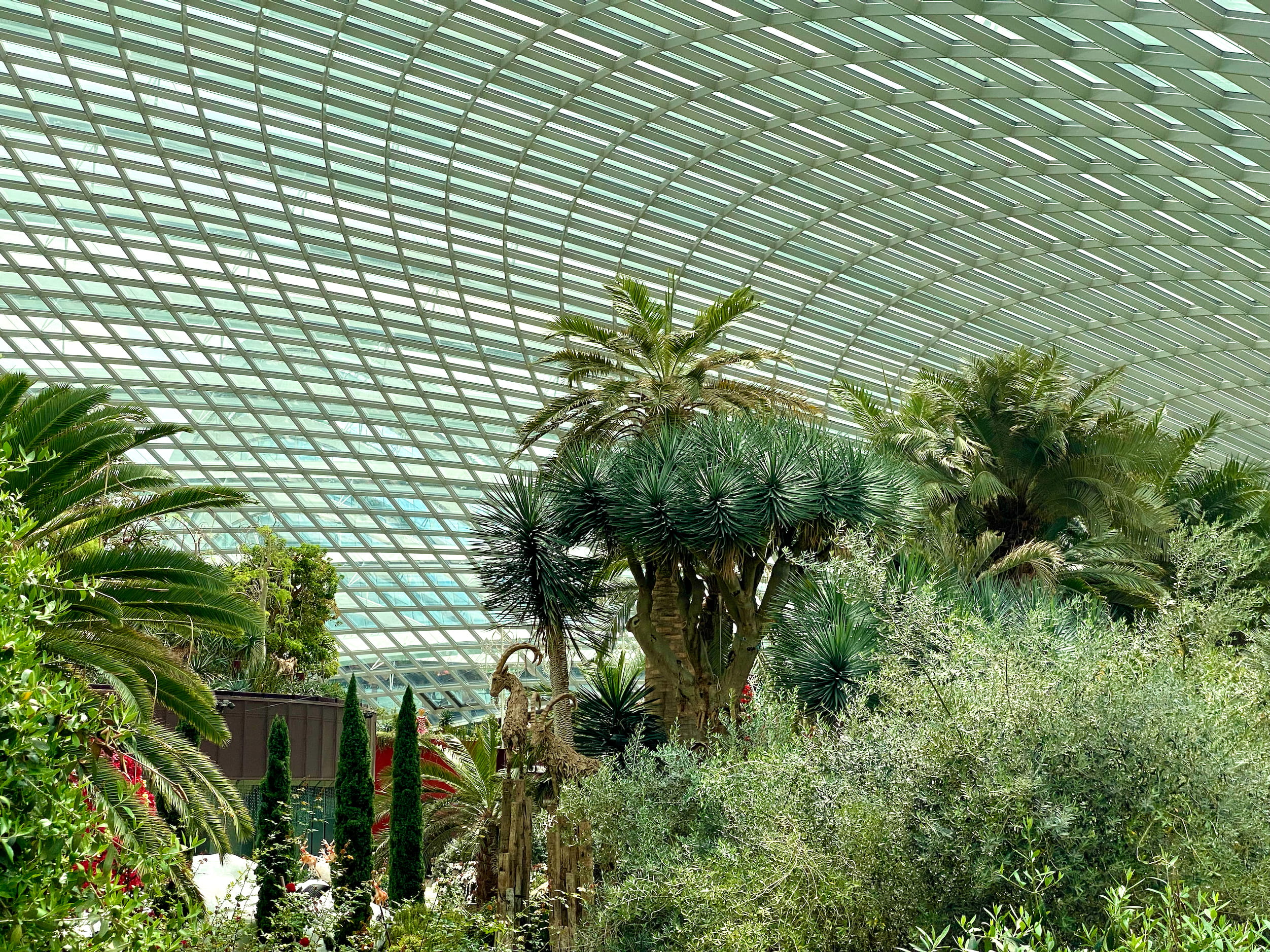
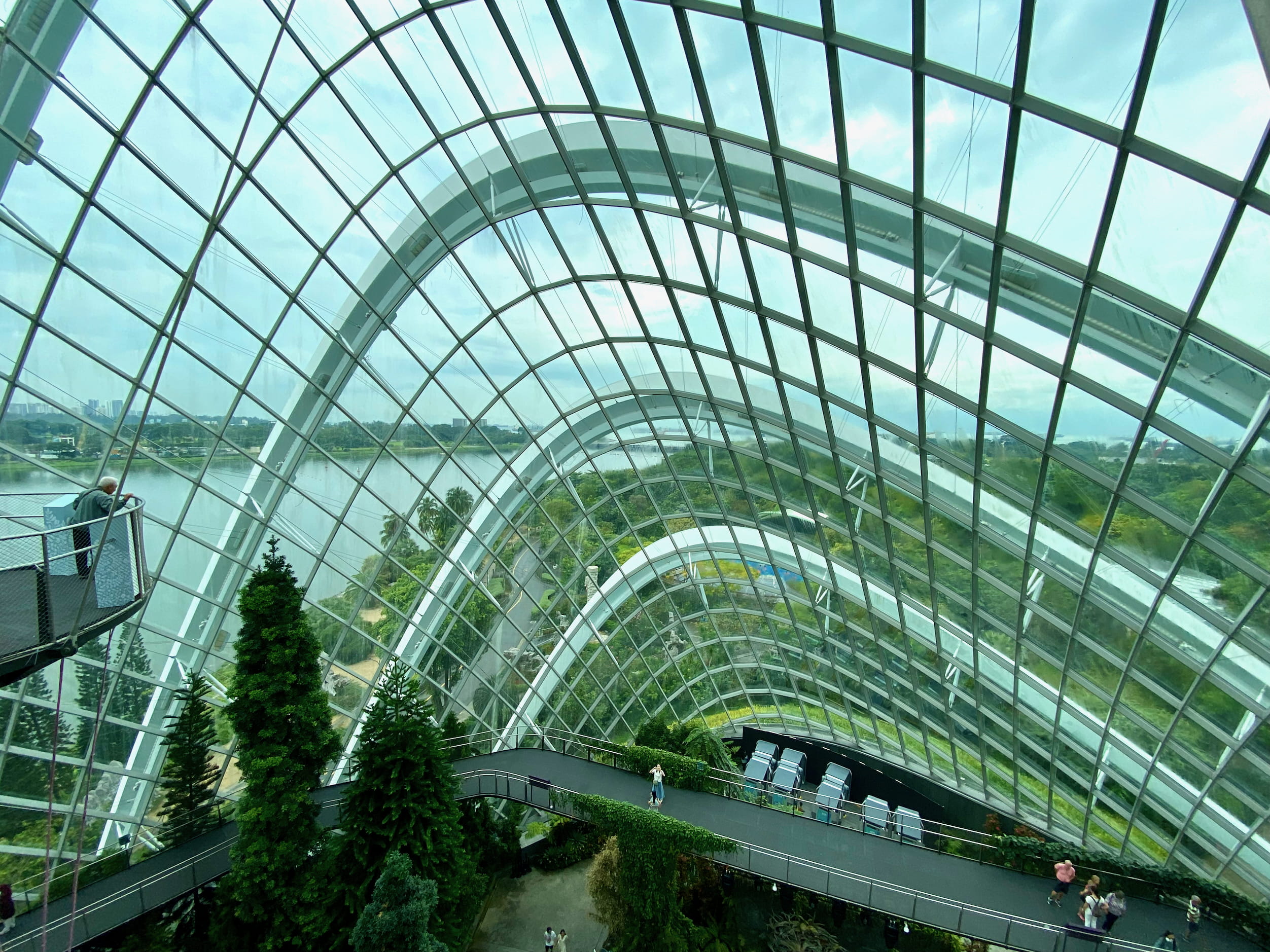
There were a few gimmicky things, like a bunch of plastic sculptures and half-working games promoting Avatar: The Way of Water , plus wood carvings and christmas trees that stuck out like sore thumbs. But that they were individually tasteful and stuck out only because of the awkwardness of their integration almost emphasized more how well-designed everything was.
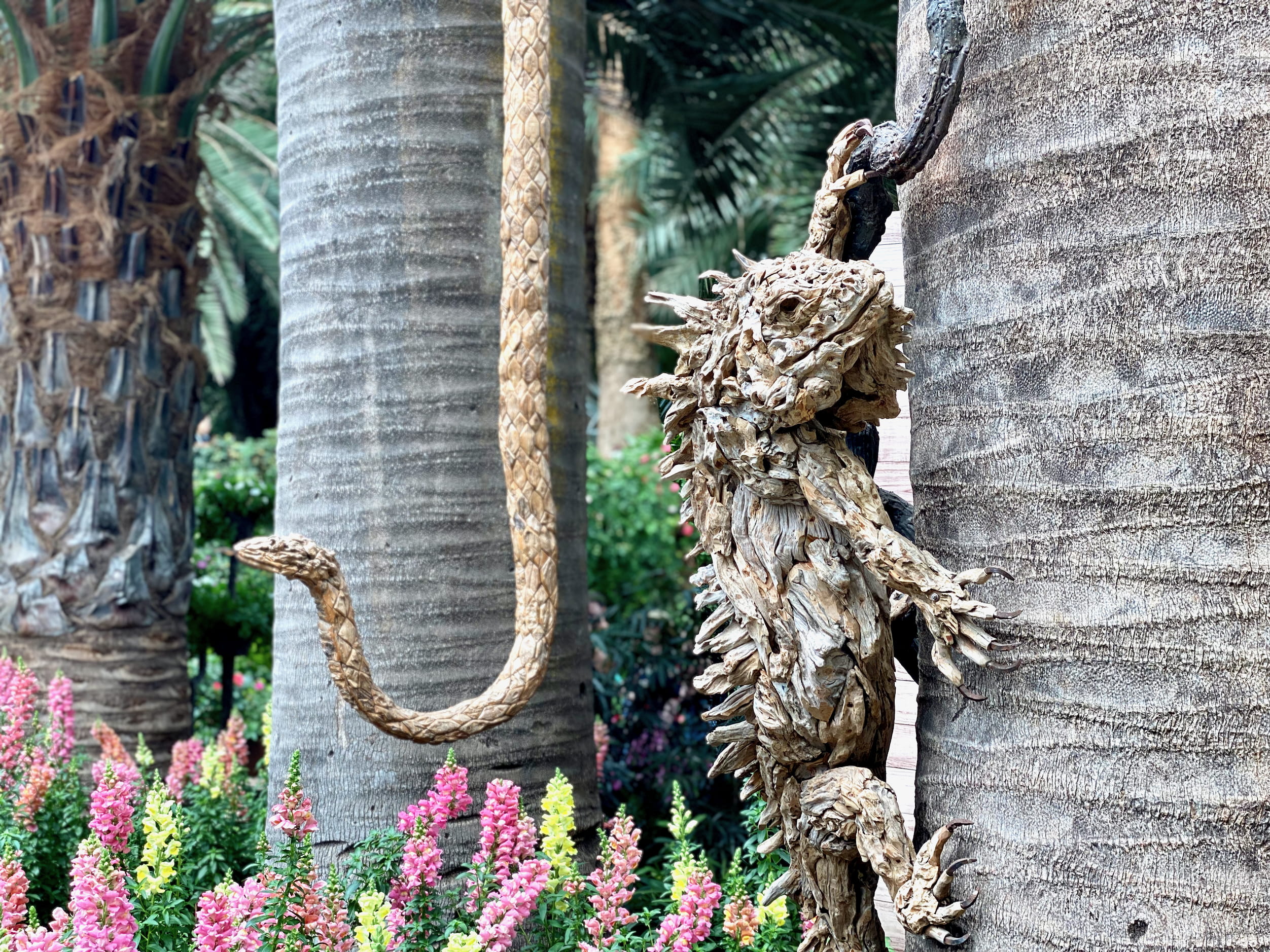
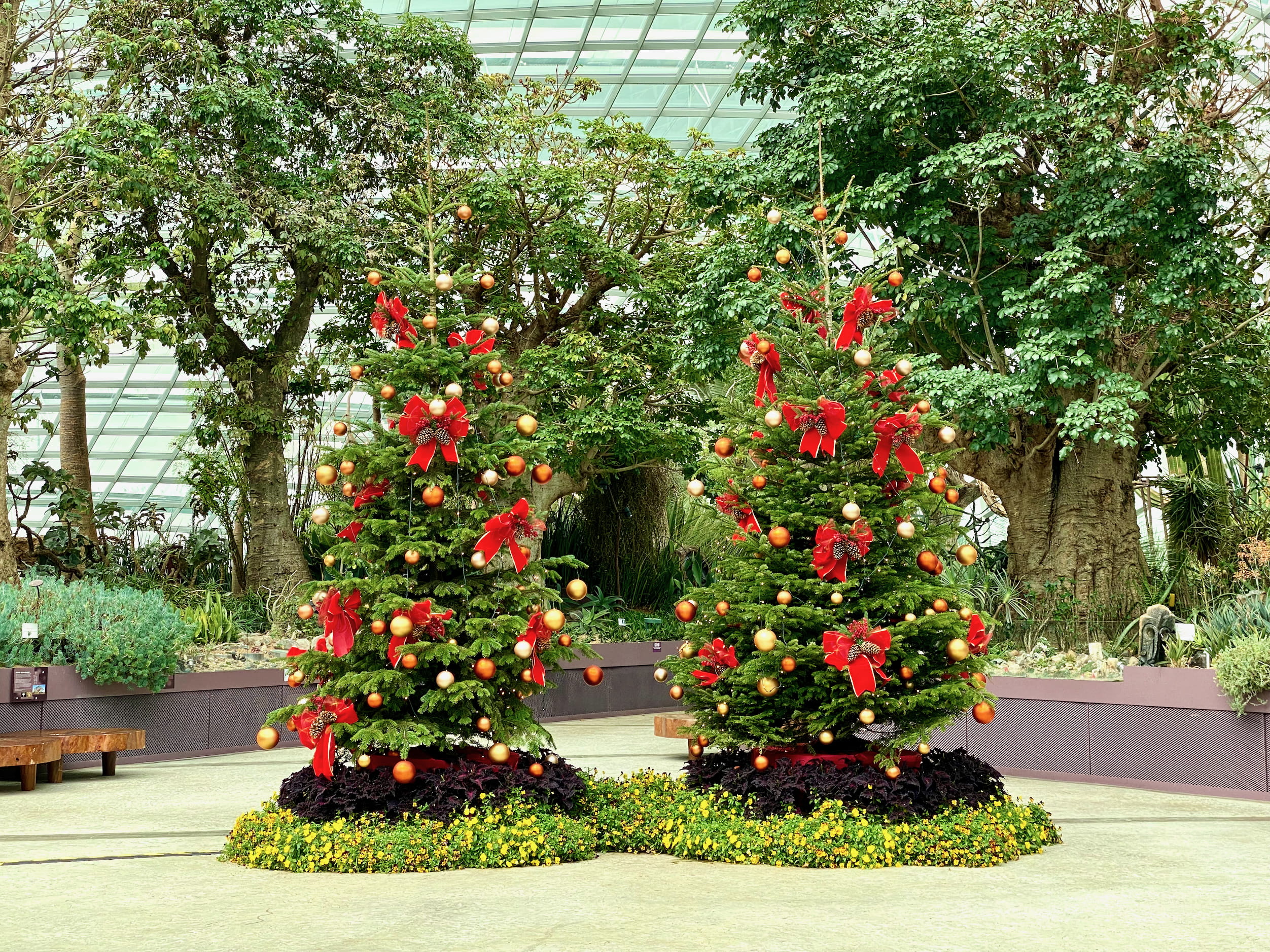
The serviced apartments we stayed at was also putting up Christmas trees. I asked the front desk how much they cost. They said ballpark $800 for a small one, and it goes up from there. The amount of Christmas decorations around town was wild, I’d say even exceeding USA standards. I asked some locals why this was so, given < 20% of the population is Christian. They said it was more of consumerism than Christianity. So we have that in common, too.
Hakwer Food
Singapore’s specialty are what they call Hawker centers. Some are still outdoors, where the name makes sense and you get the novelty of the occasional cockroach.
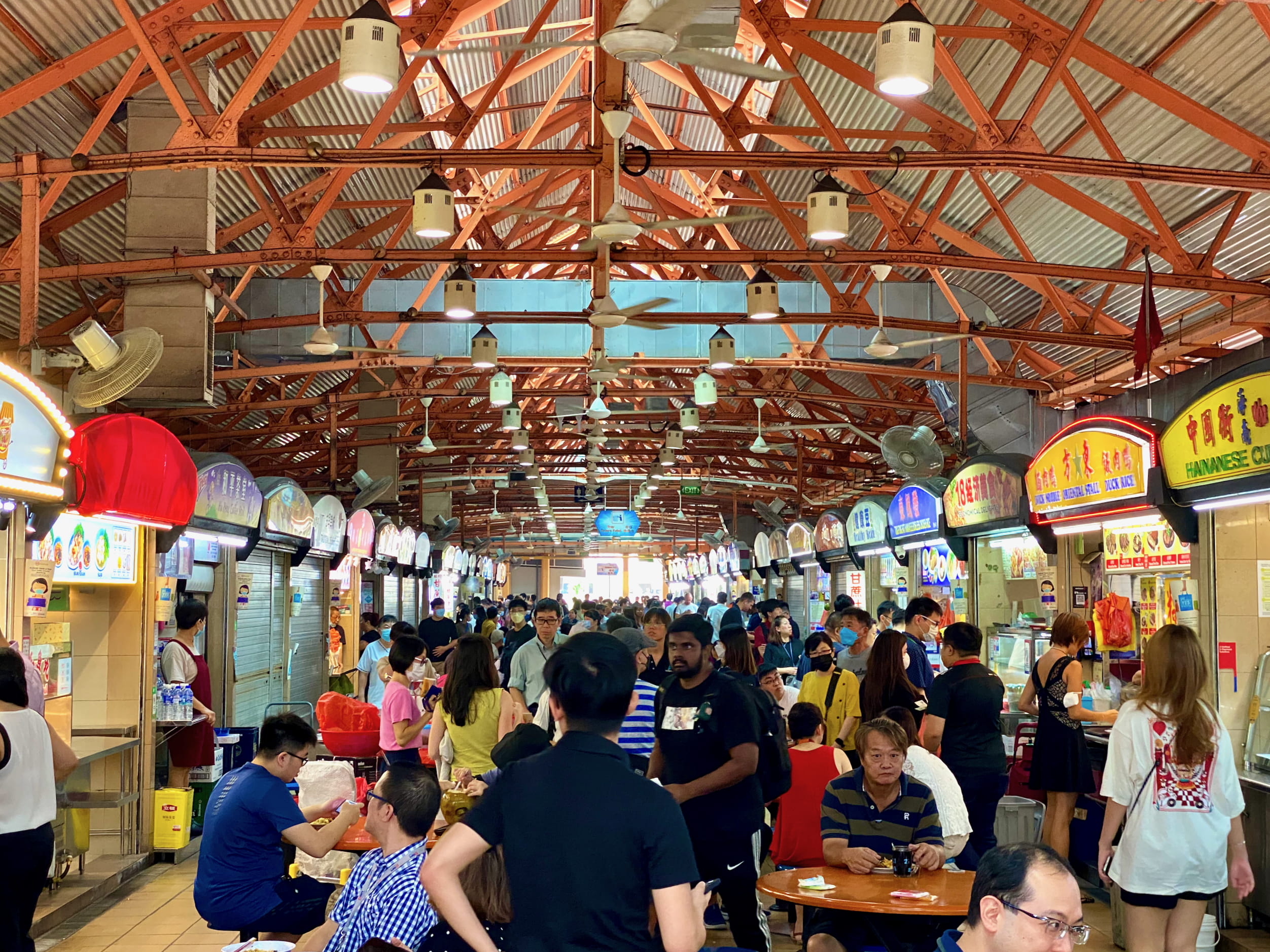
Deafening rain going on outside.
Many modern hawker centers are in malls. This seems strange—shouldn’t we just call them restaurants at this point?—but then you remember people love air conditioning and kind of go with it.
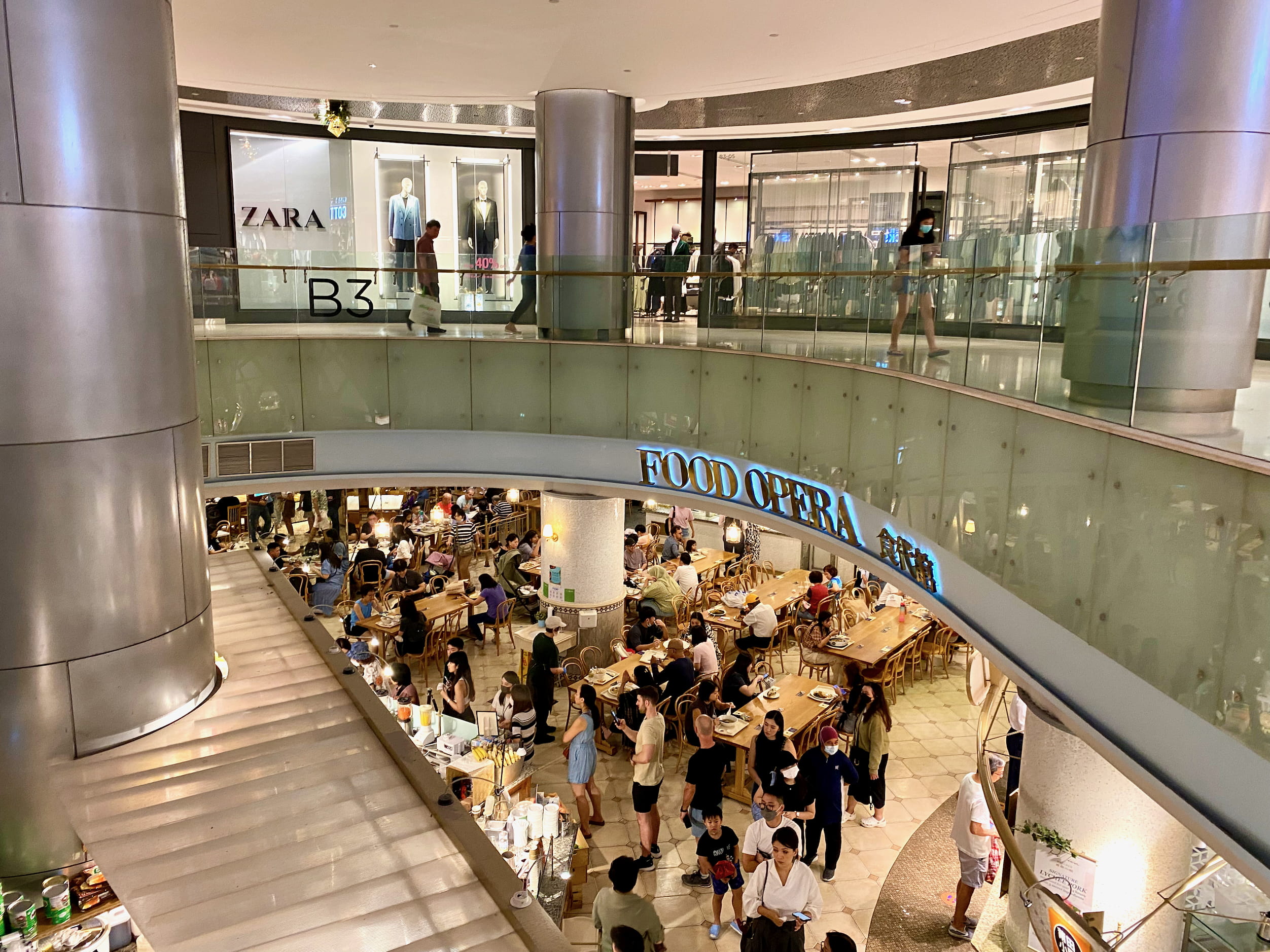
Modern day hawker center, mall basement.
Hawker food, especially at the outdoor stalls, is delightfully affordable. I love it when a city lets you can eat cheap but well. And, of course, if you want to spend serious money, that is also readily available. Here’s a small food montage of shrimpy, garlicky, fishy heaven.
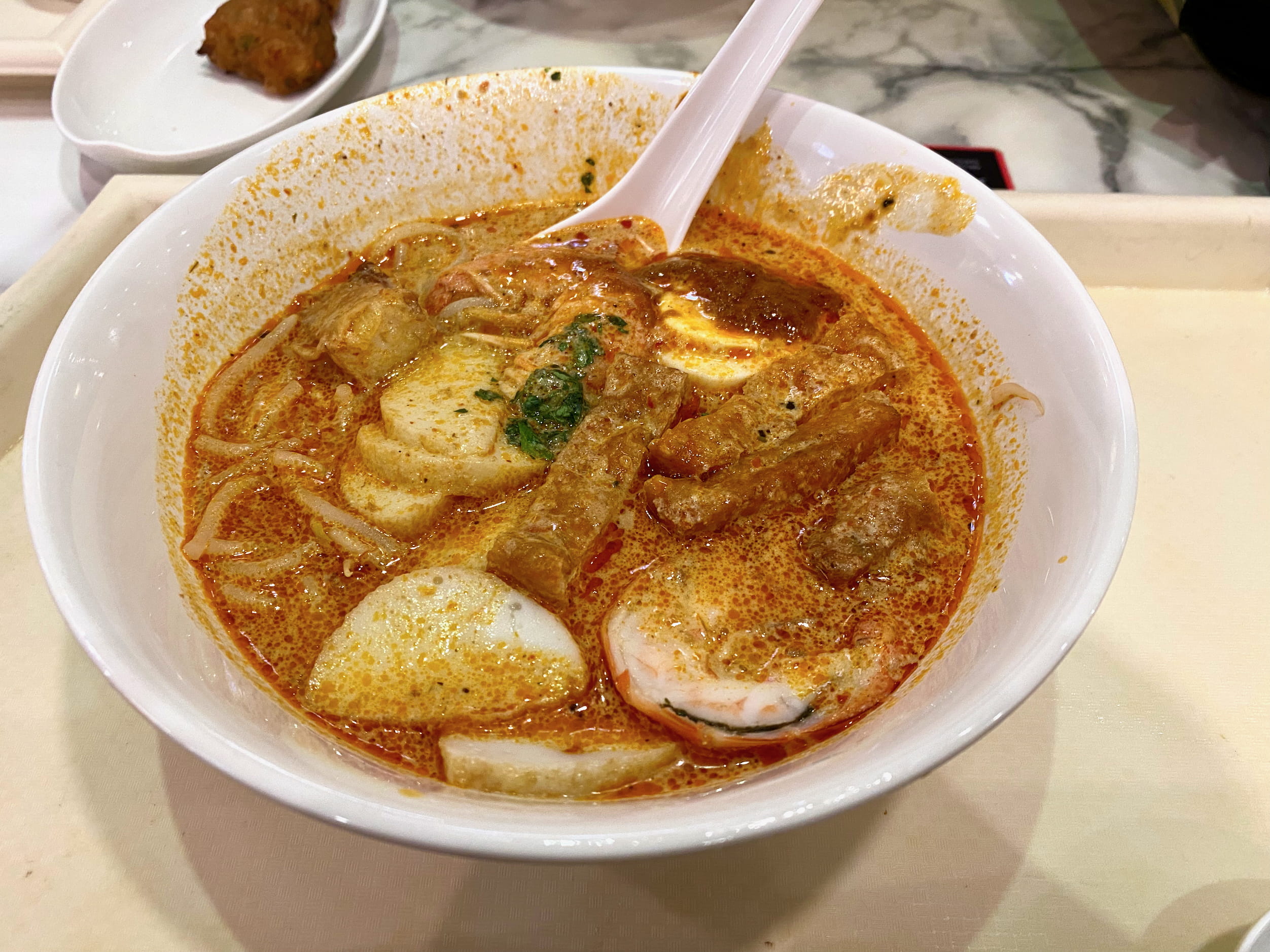
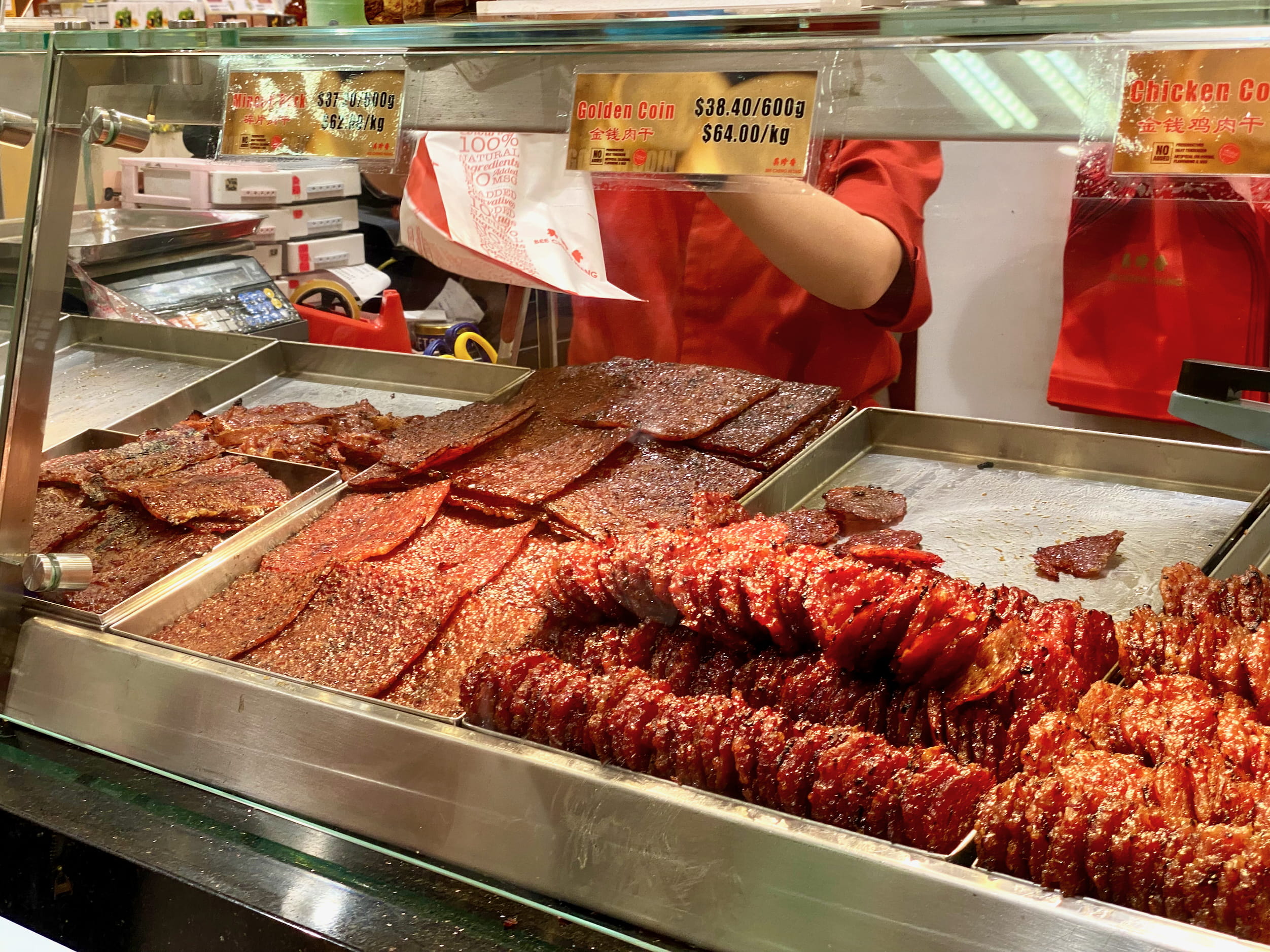
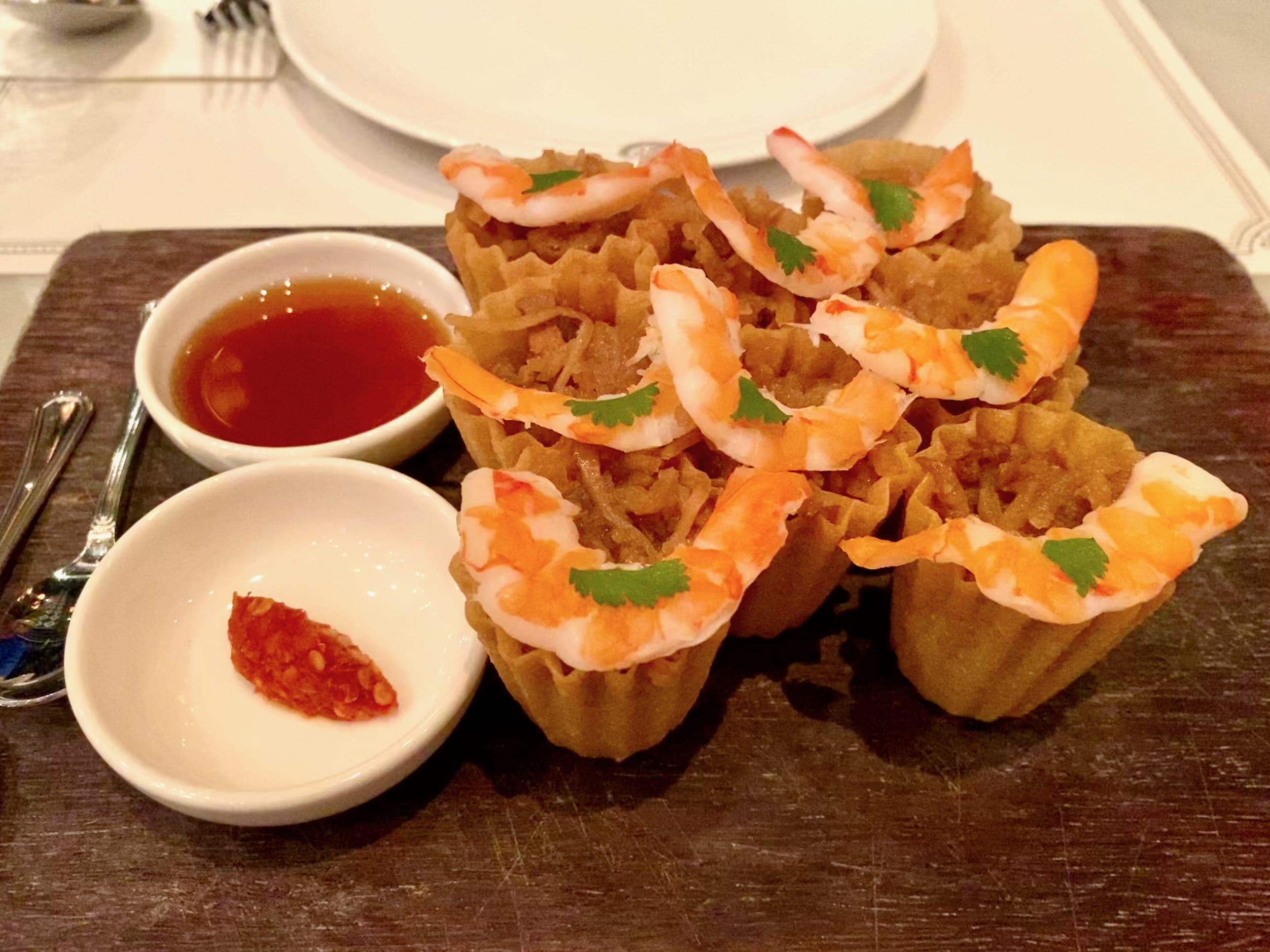
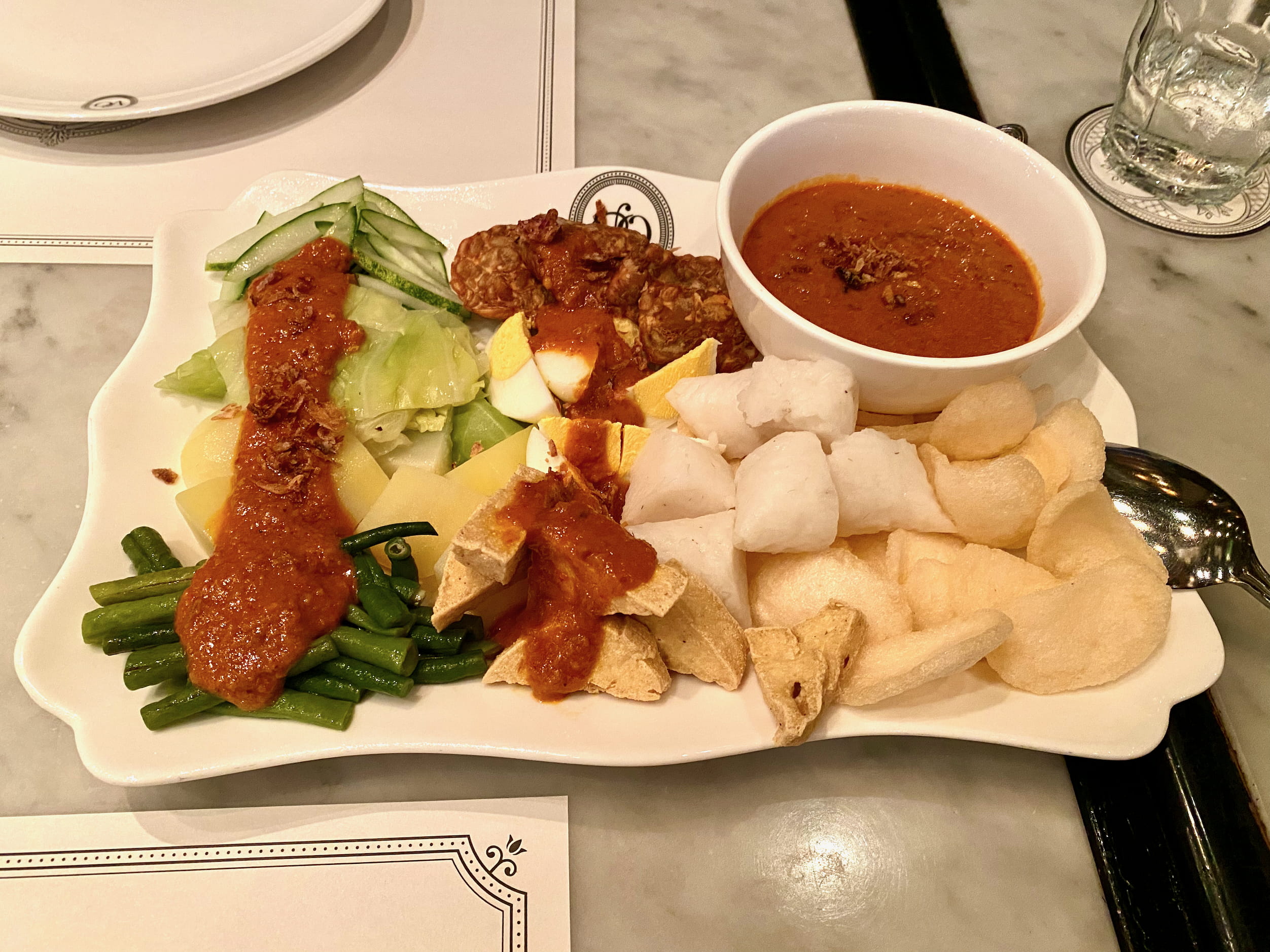
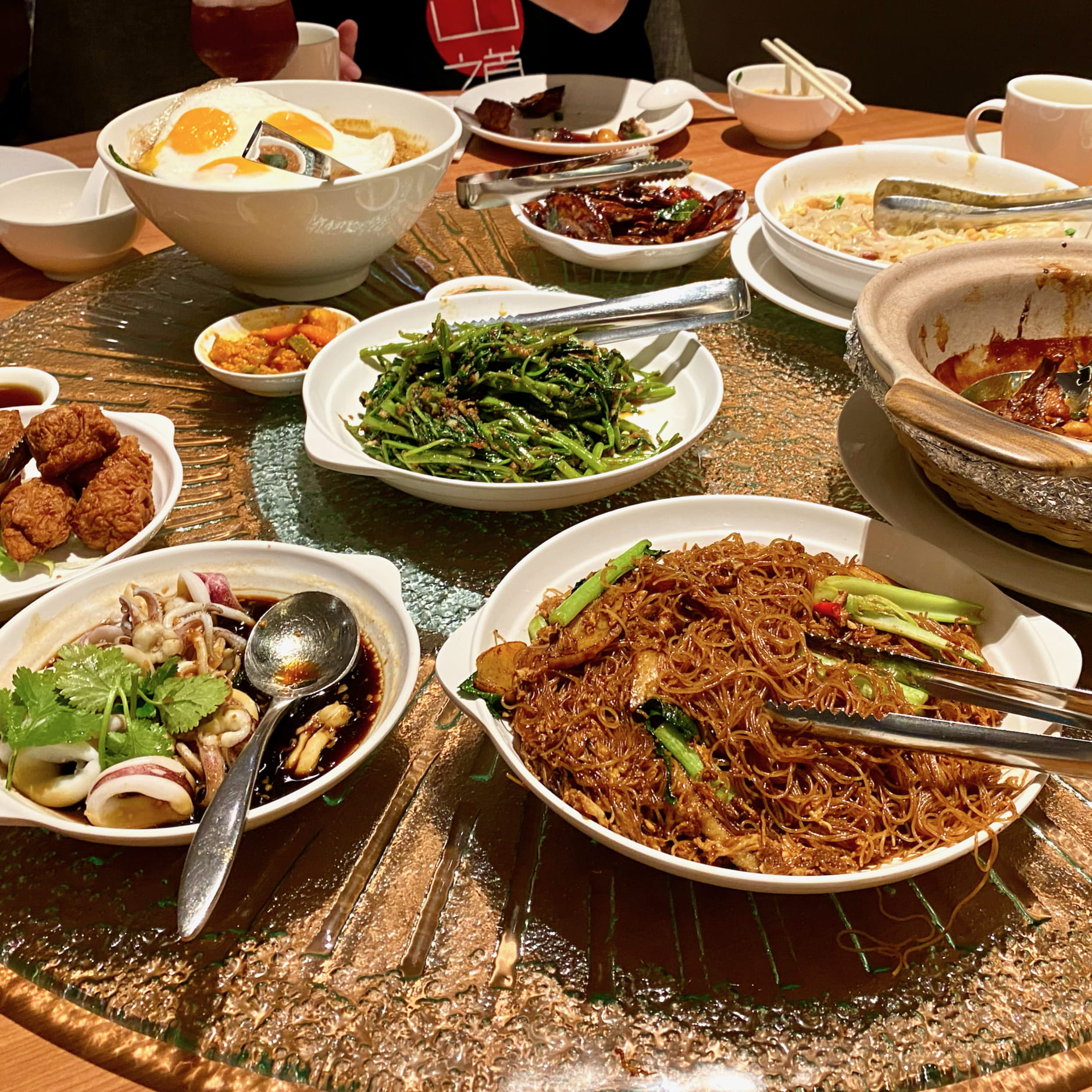

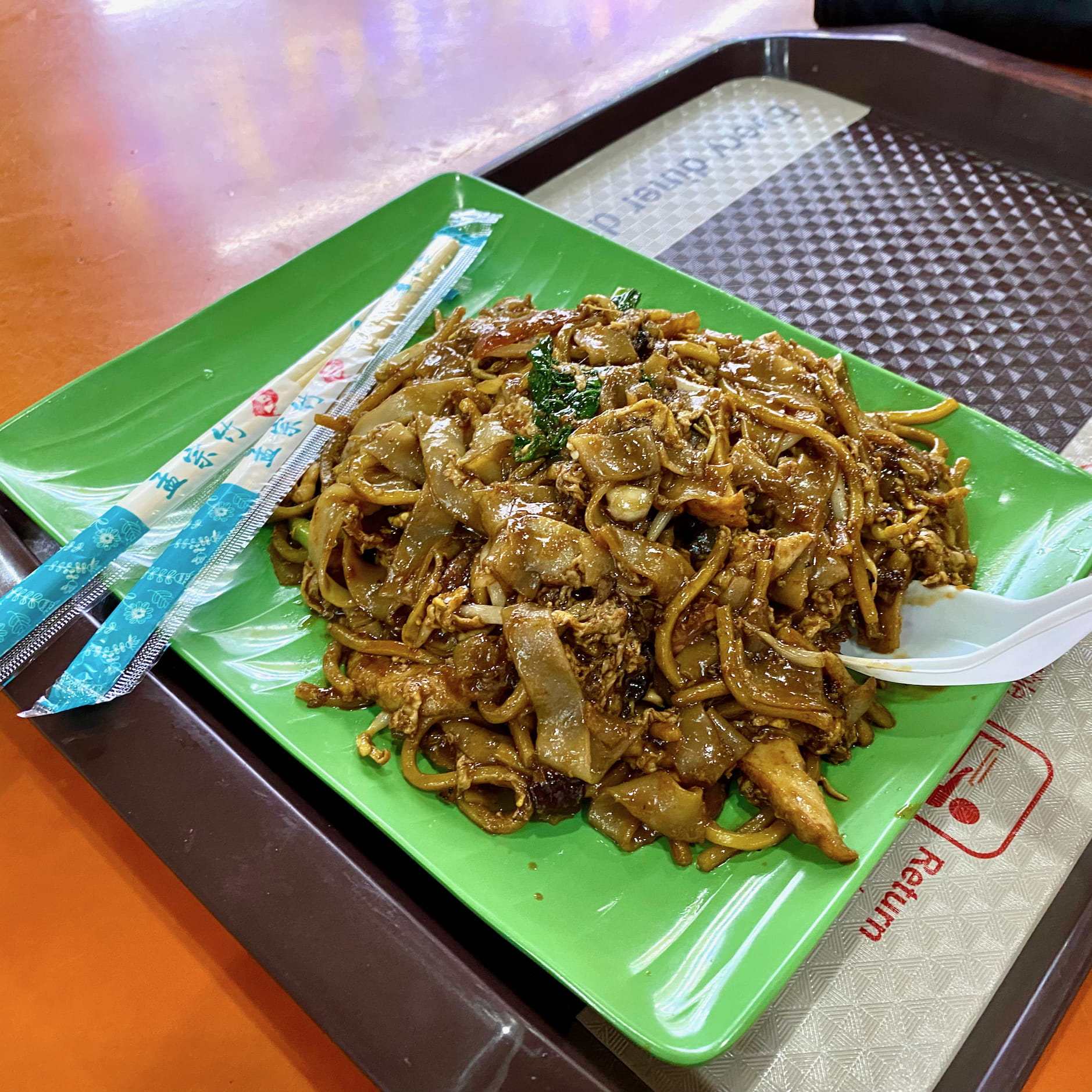
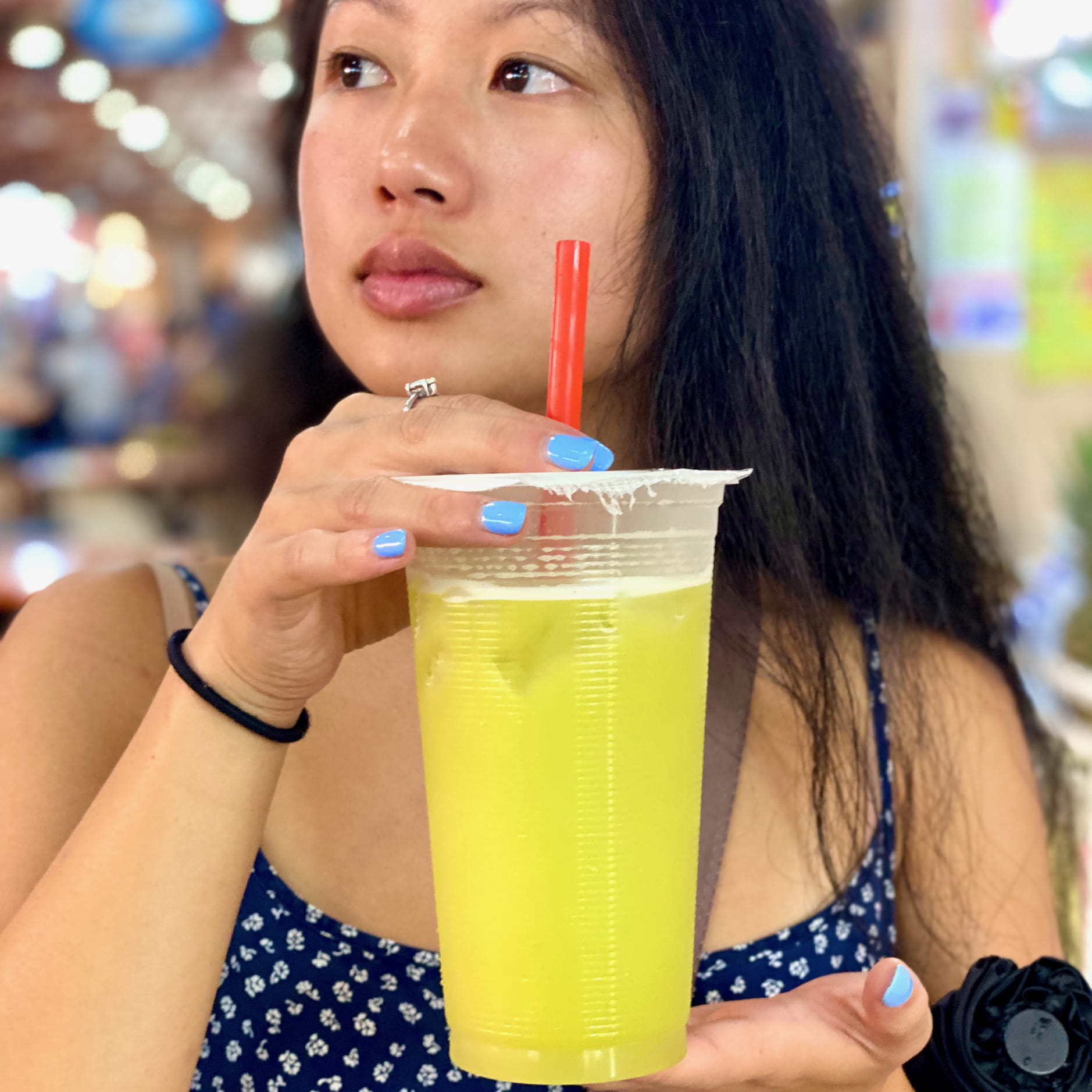
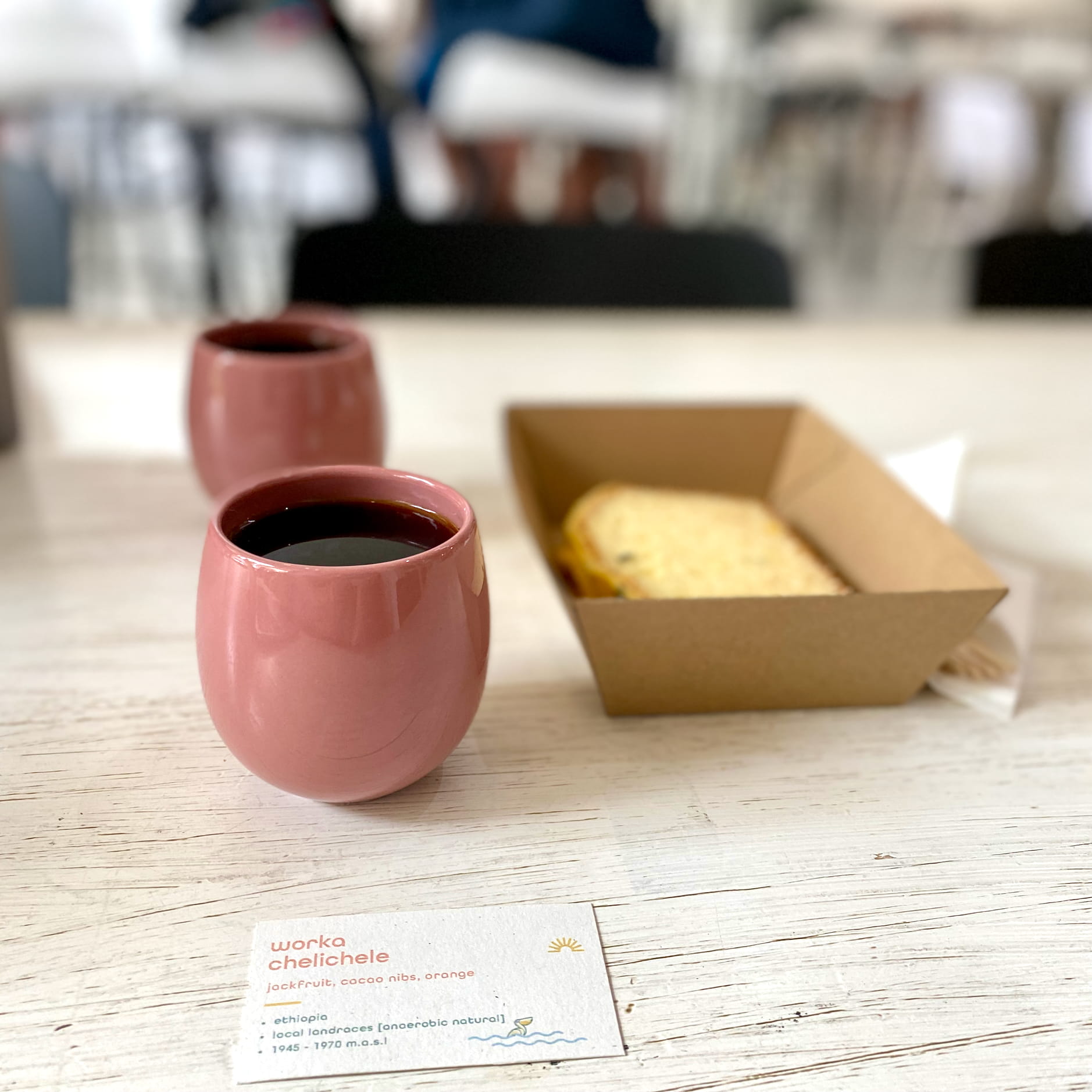
Also, fresh squeezed (crushed?) sugar cane juice and appropriately overpriced hipster coffee.
Urban Design and Eco Aesthetics
Singapore plans long term. The government has effectively one political party, which has been in power since 1959. It has deep control over the society, which we’ll touch on later. But this means it can make extensive city planning decisions.
We visited the museum they’ve set up for their own urban planning which talks about two tiers of planning:
- The Long-Term Plan, the 40–50 year strategy
- The Master Plan, the 10–15 year detailed plans for executing the long-term plan
This leads to both immensely pleasing land use schemes and shared infrastructure. The land use puts space hungry—but briefly visited—things underground, like parking lots, supermarkets, mass transit, and utilities. This, plus vertical building, allows light in living and working spaces, and makes room for greenery. And the shared infrastructure has stuff like pipes distributing district-wide air conditioning and chilled water, which is more efficient than everyone individually producing their own.
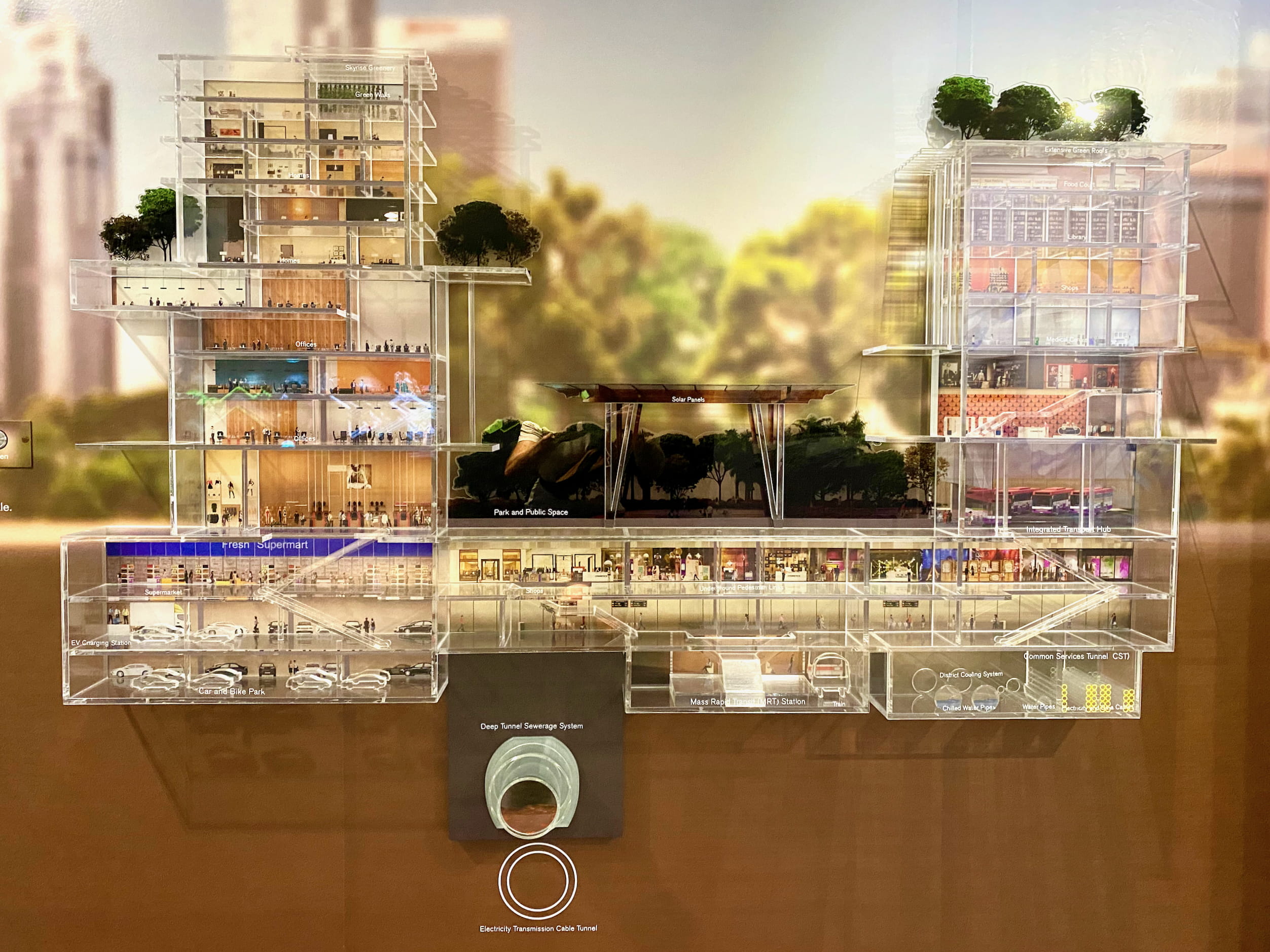
This kind of attention to detail, competence, and actually getting things done makes me—how do I put this—extraordinarily jealous.03 I’m not saying that it’s worth totalitarianism, but there’s just a deep feeling of competence and giving a shit-ness that the urban planning here really exudes. It also probably doesn’t hurt that the country is both extravagantly wealthy and tiny.04
With that said, I don’t really know how much of all the design was working. Public transit certainly existed, with a decent rail network and gleaming stations. But the stations were often pretty empty. And most places we wanted to go, the metro was sort of helpful, but not quite perfect. Plus, despite gargantuan overhead costs to owning cars,05 everyone we met preferred to get around by car and owned (at least) one.
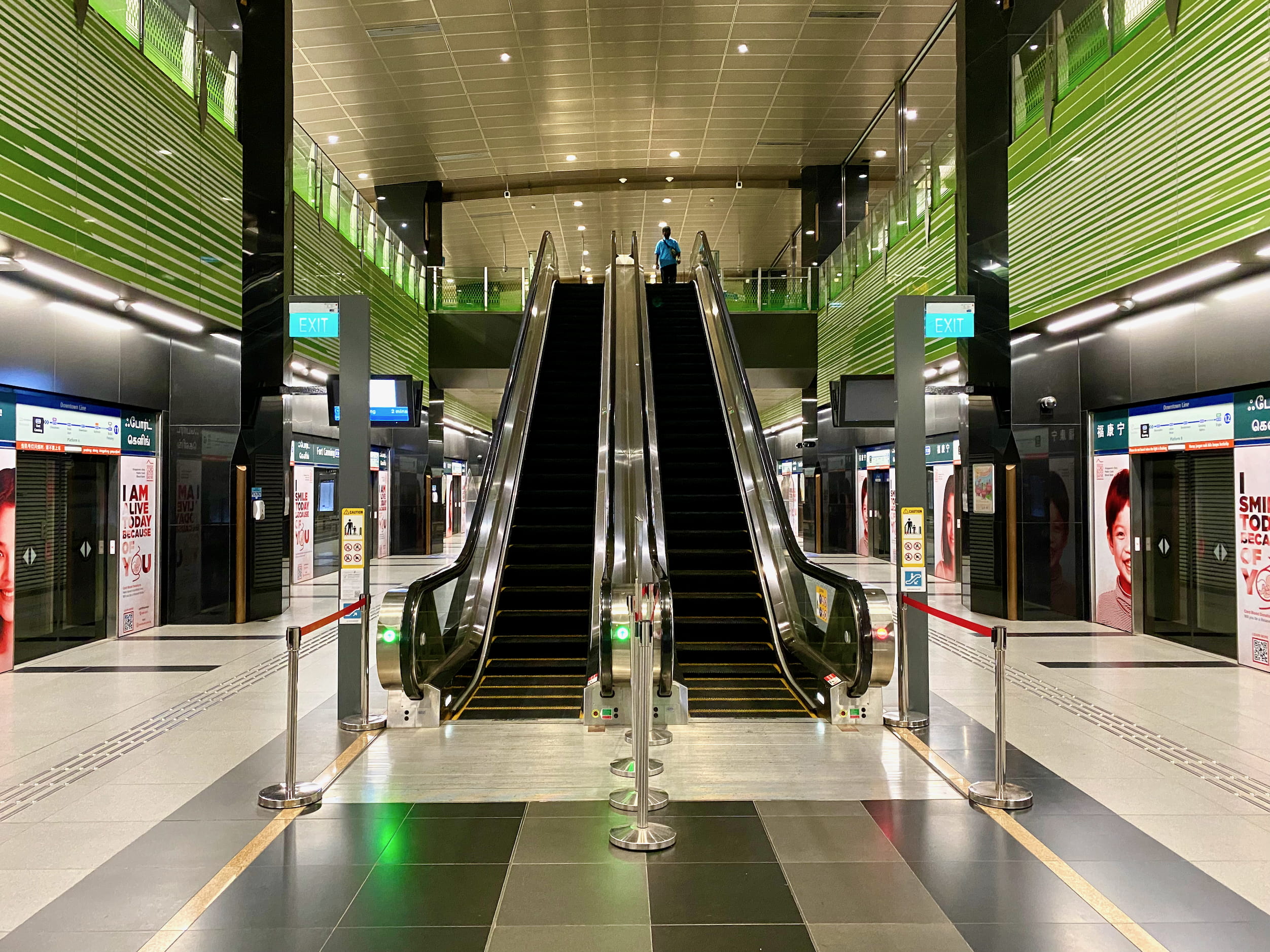
Gleaming and conspicuously empty.
Whether or not this true, it felt like the metro system was superimposed post-hoc on a city whose people looked down on it.06
Like Seoul, the skyline is interesting and varied, and integrates modern with traditional. Here’s some b-roll of around town.
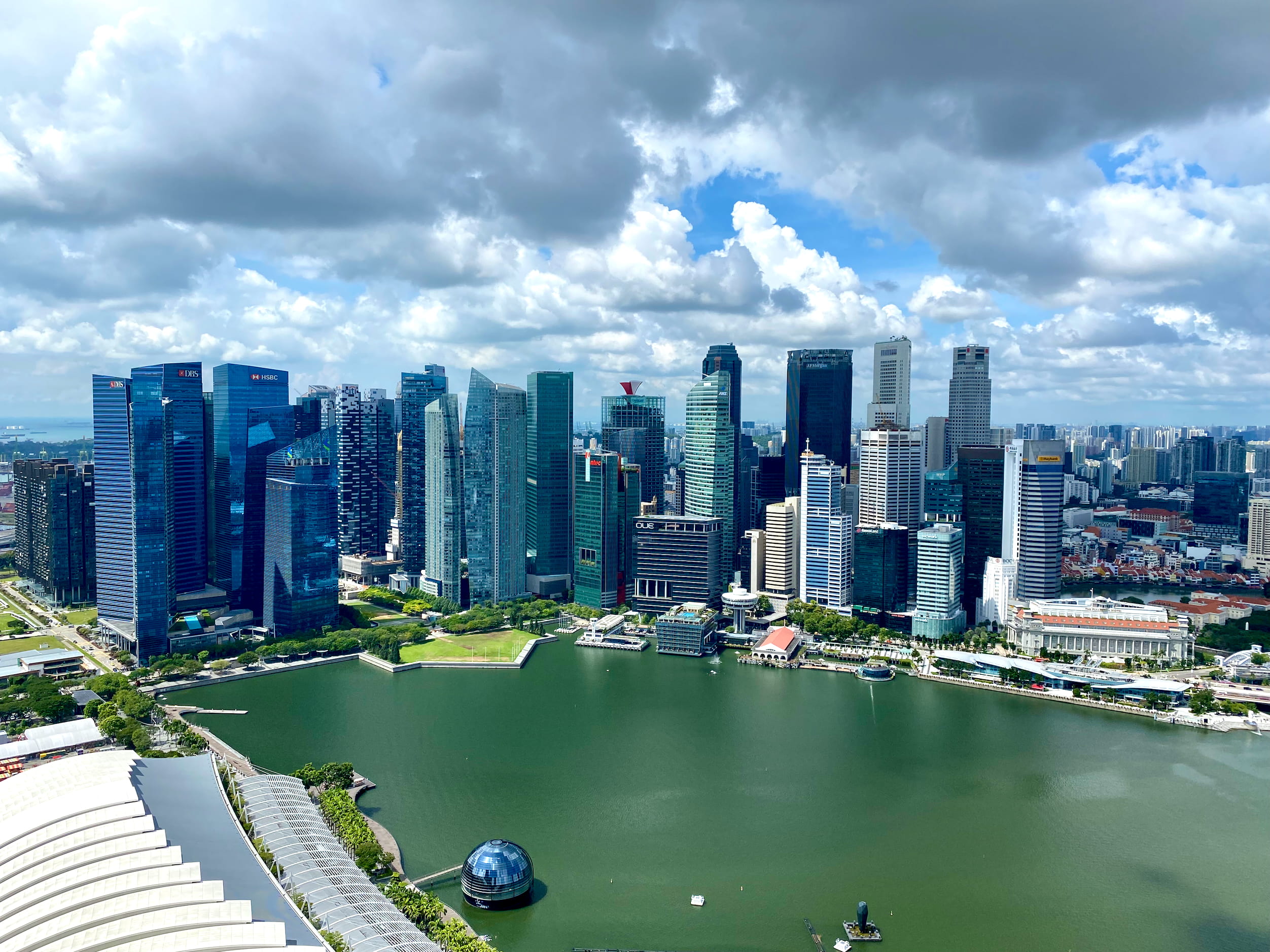
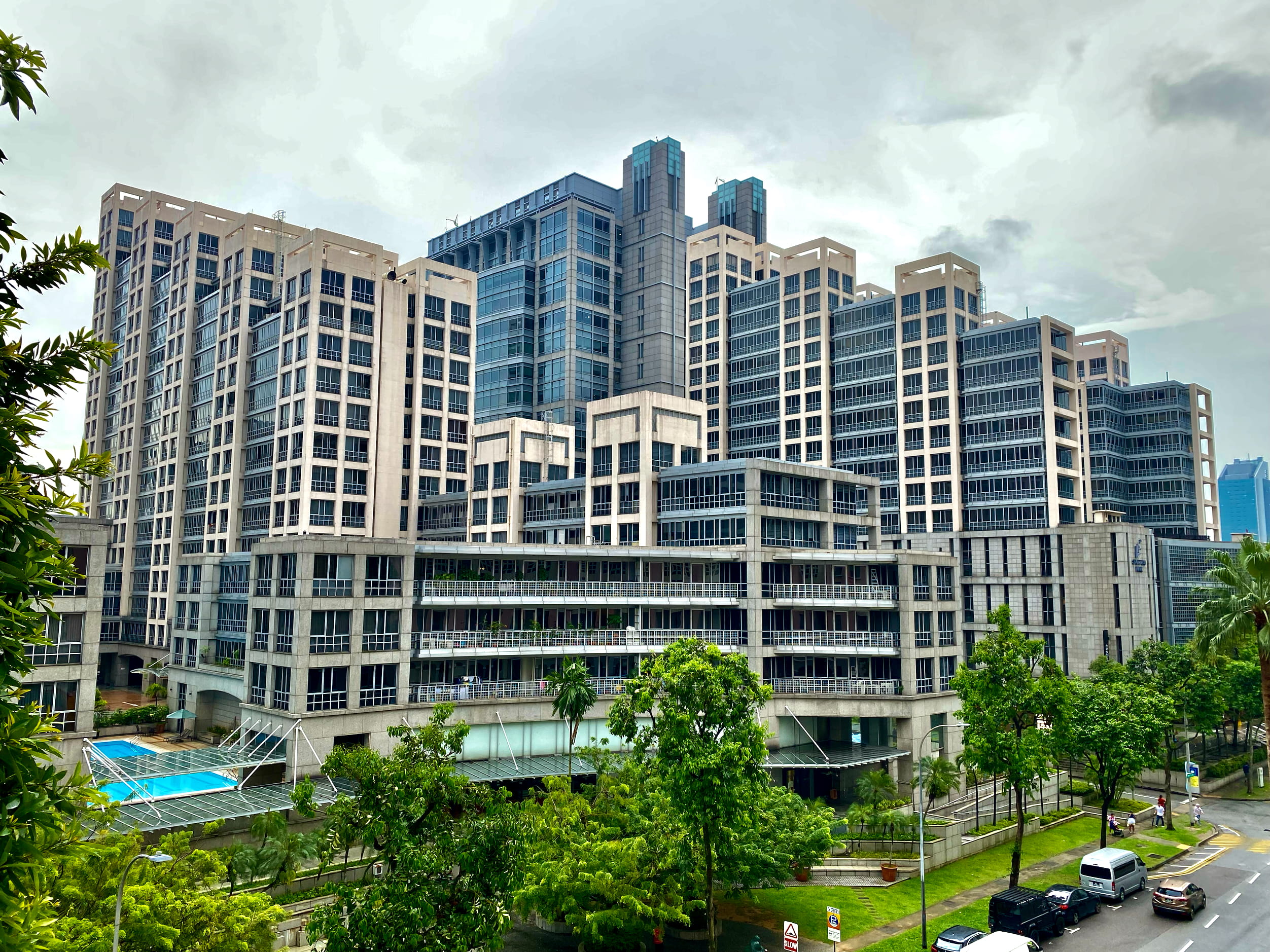
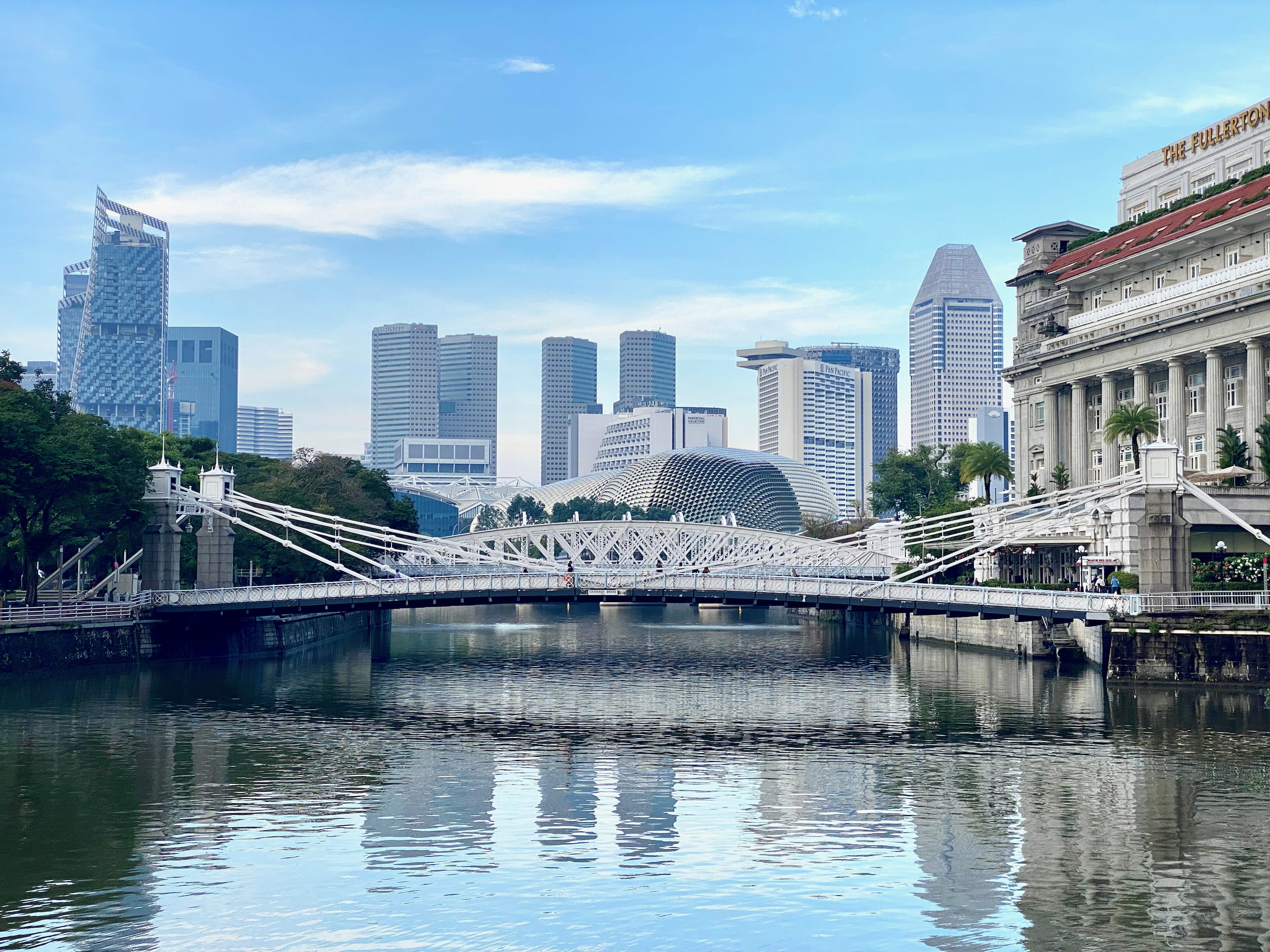
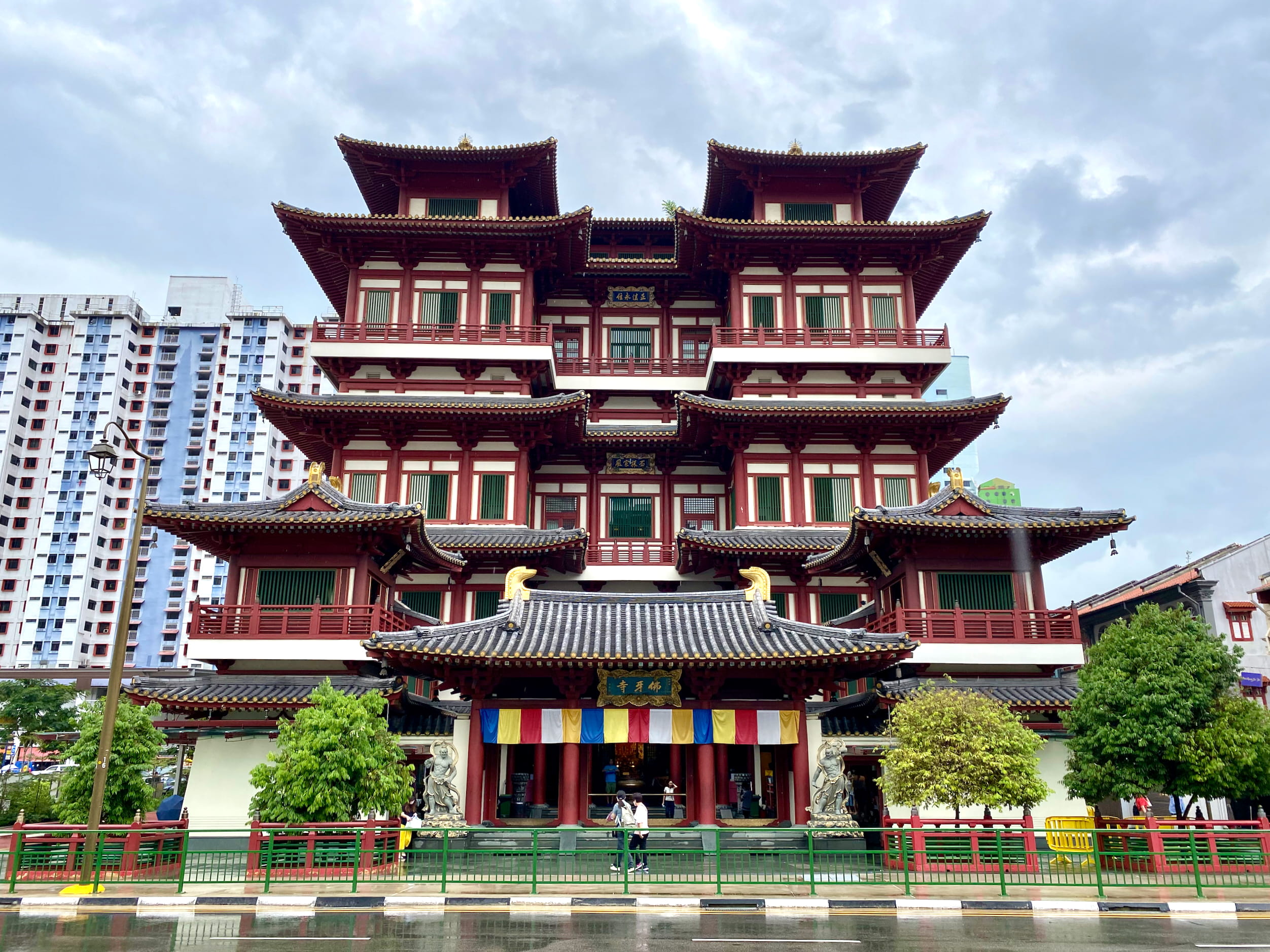
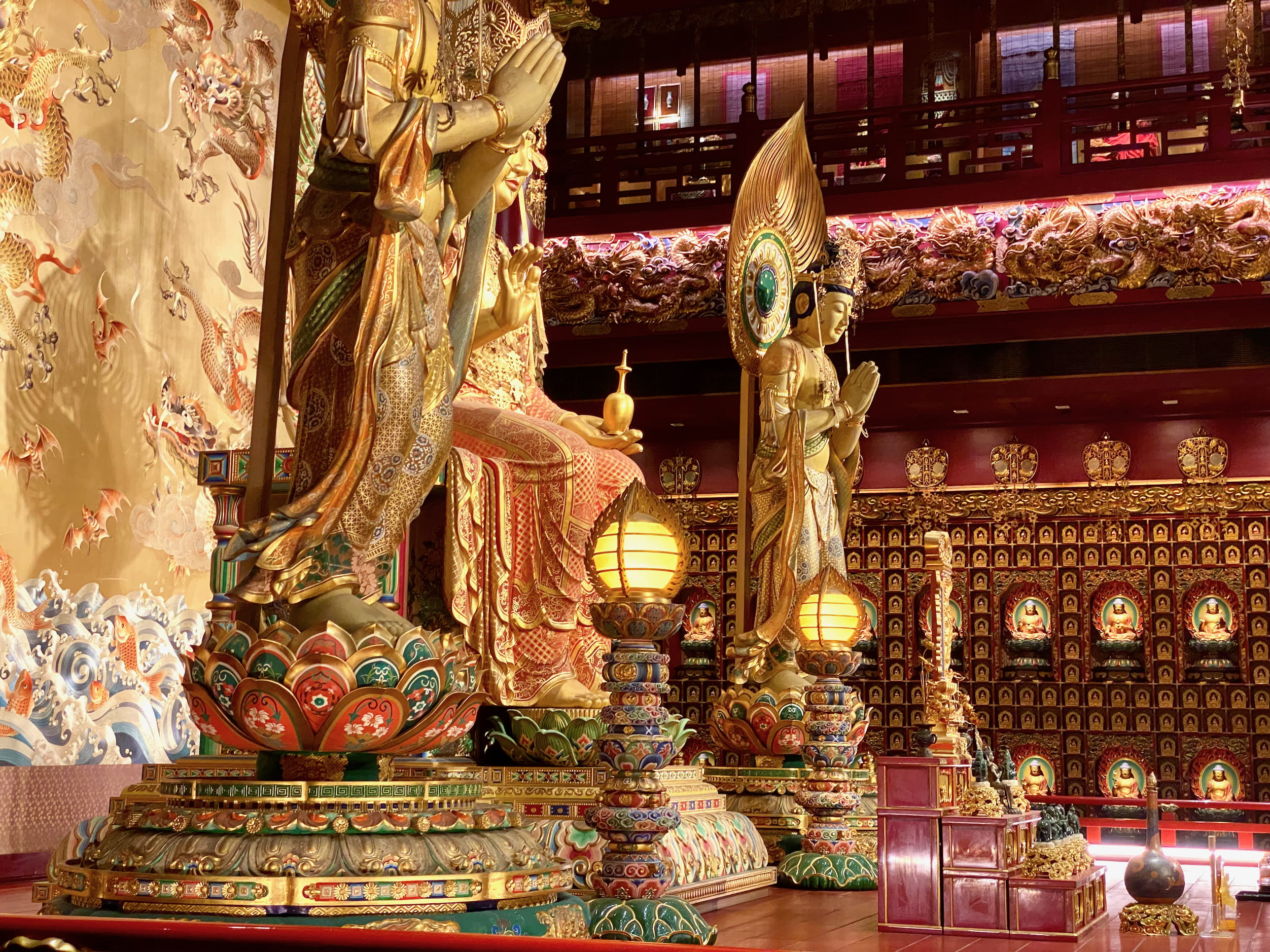
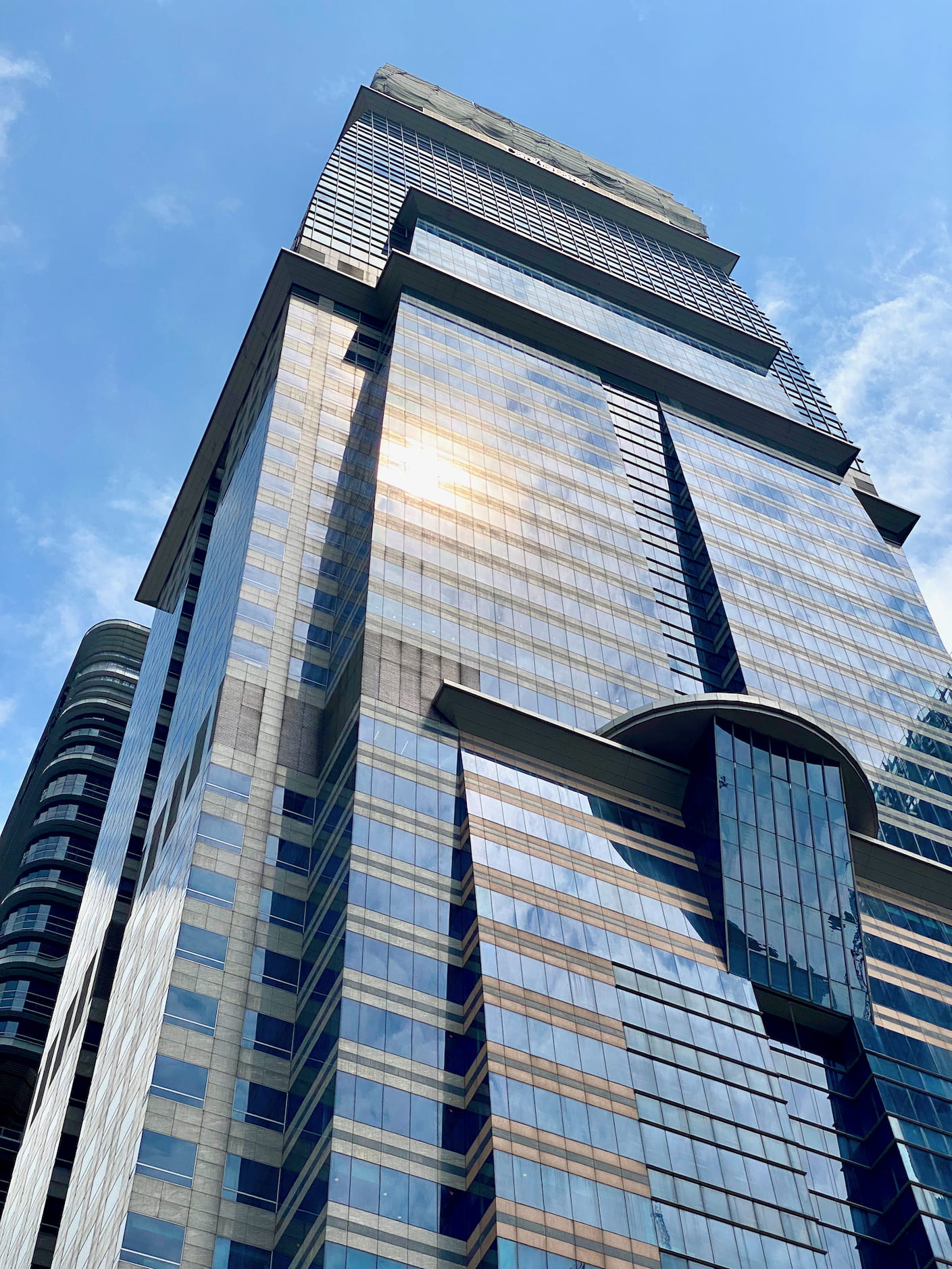
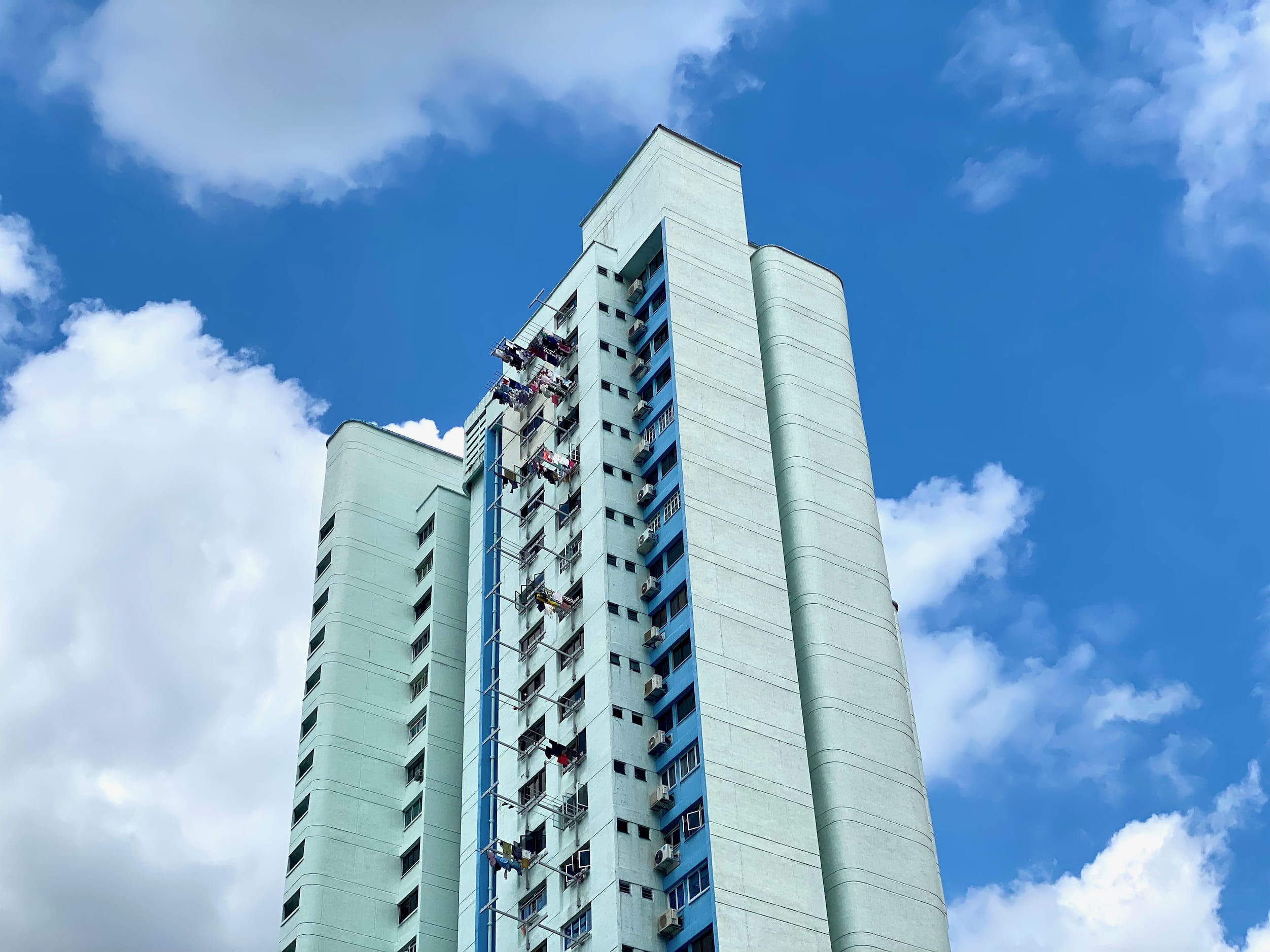
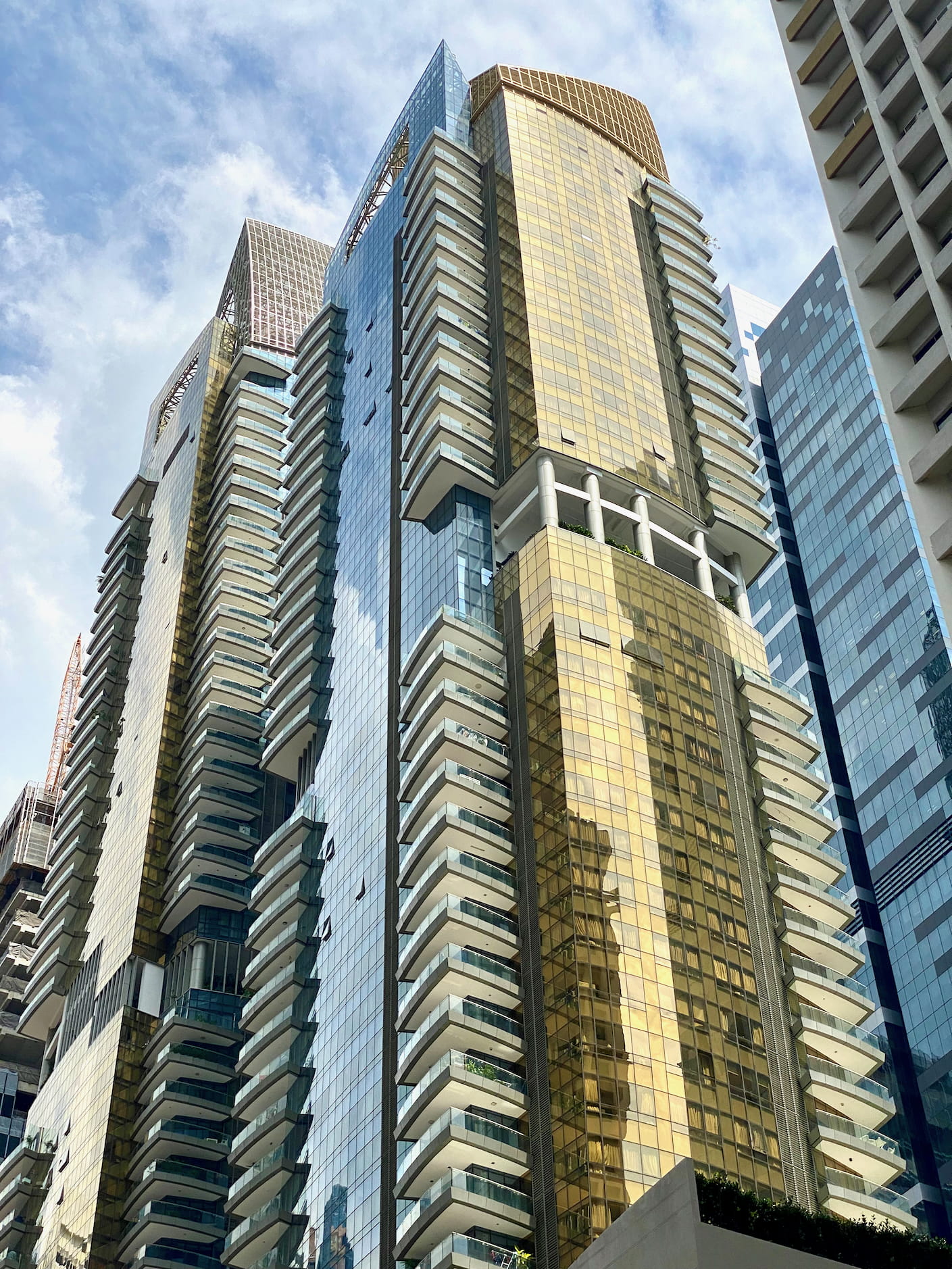
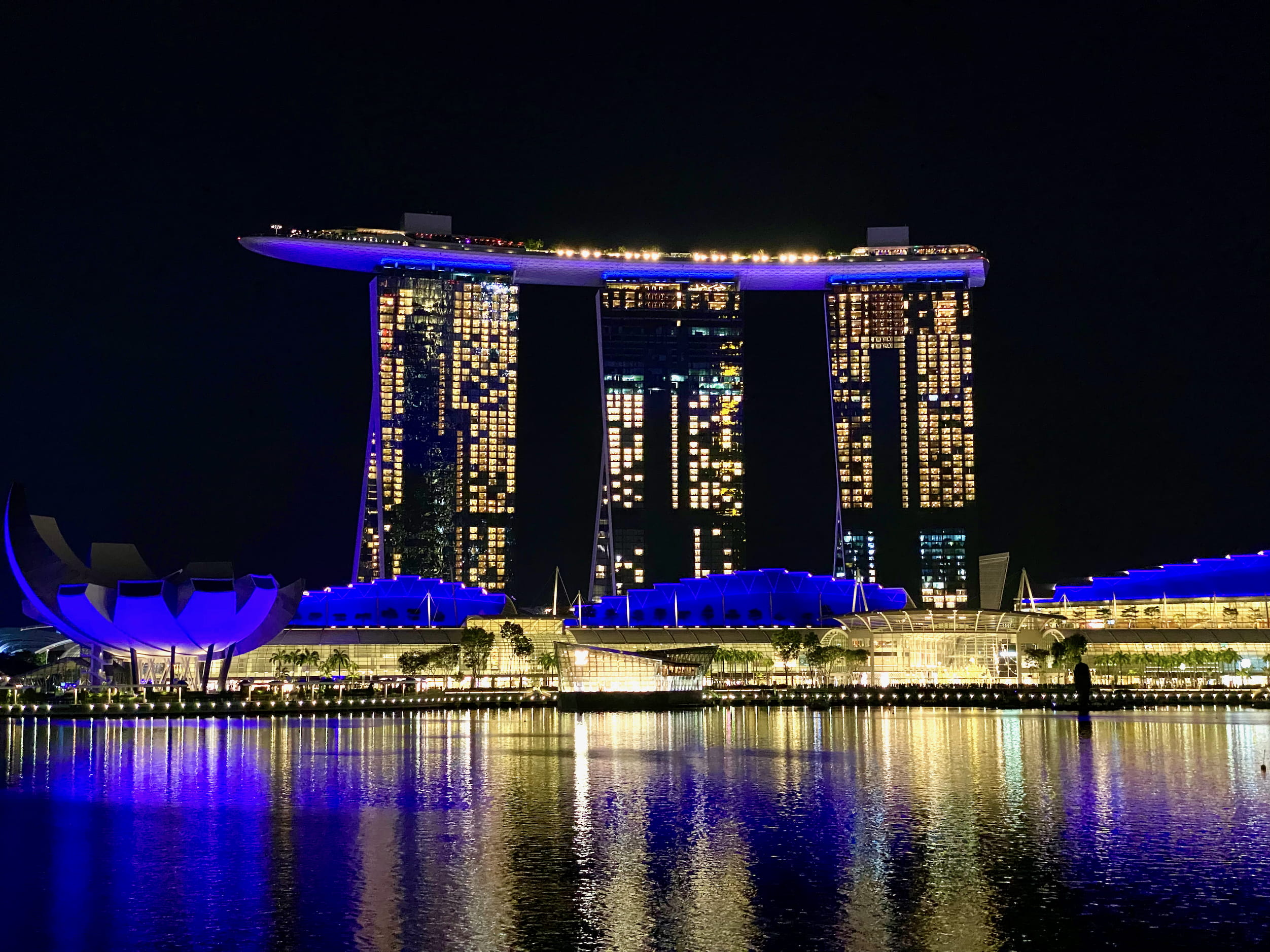
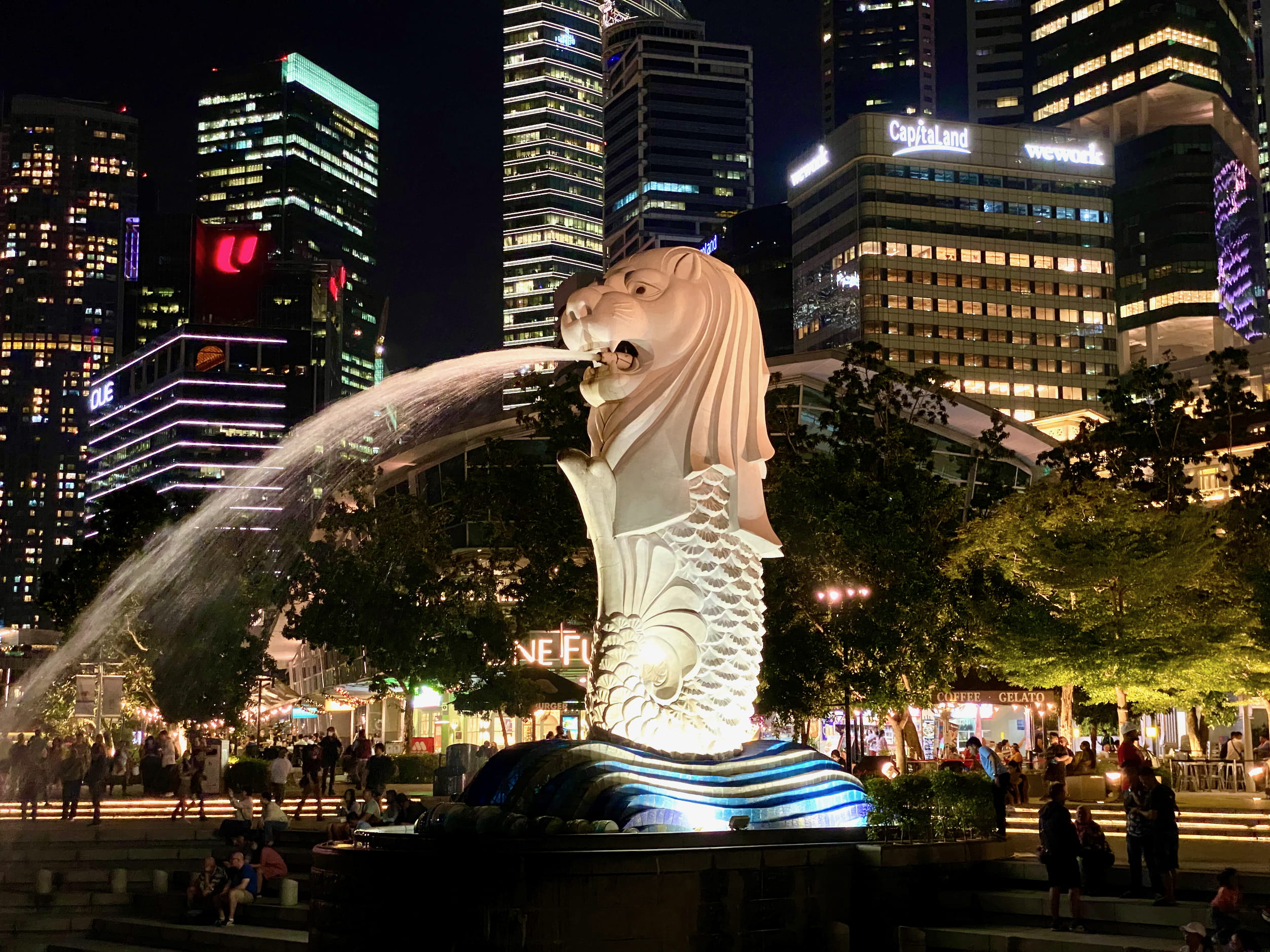
The city has a pristinely landscaped and kempt Botanic Gardens, apparently one of only three gardens in the world that’s a UNESCO World Heritage Site.07 It’s even one of the rare things you can check out for free.
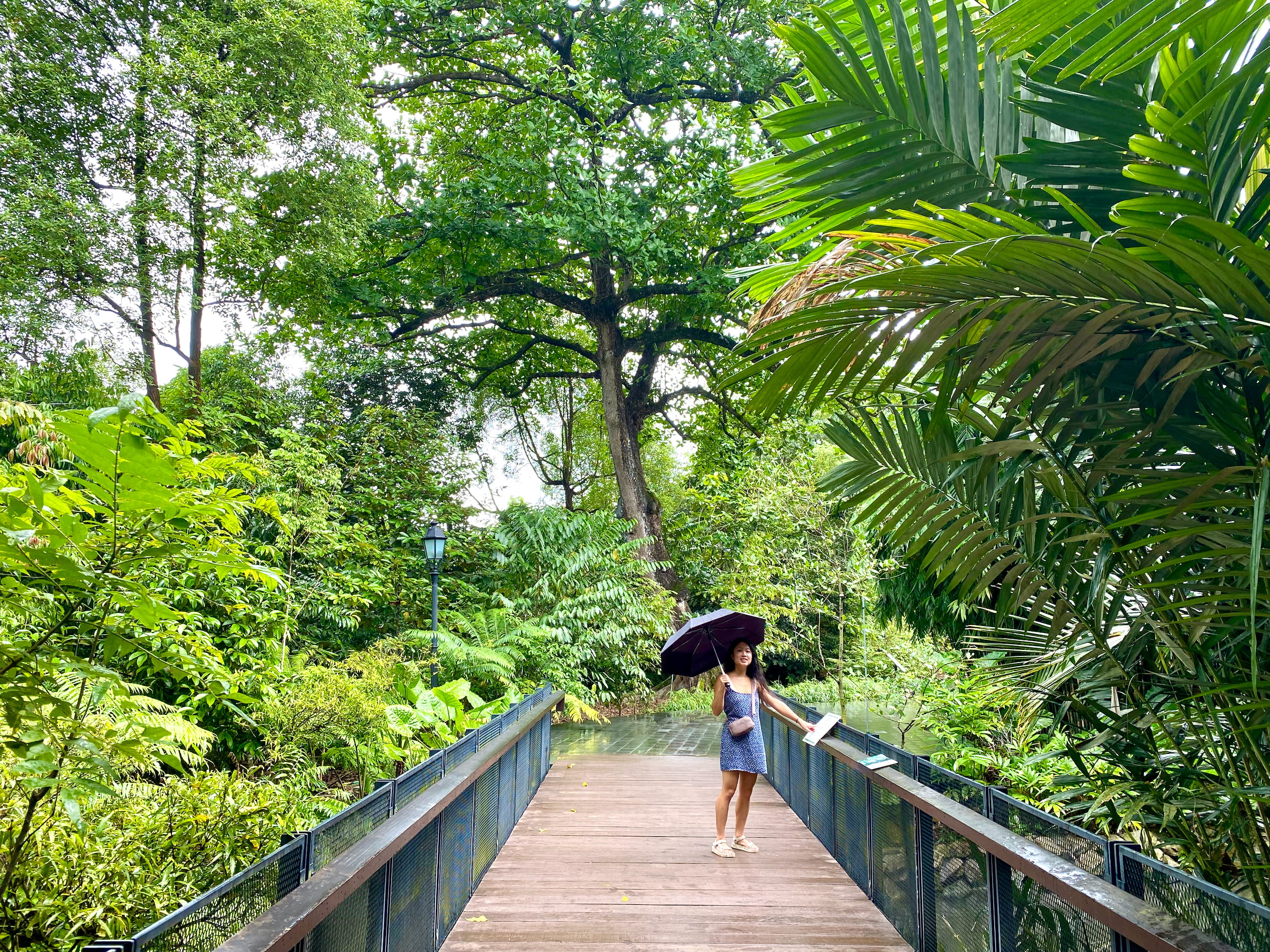


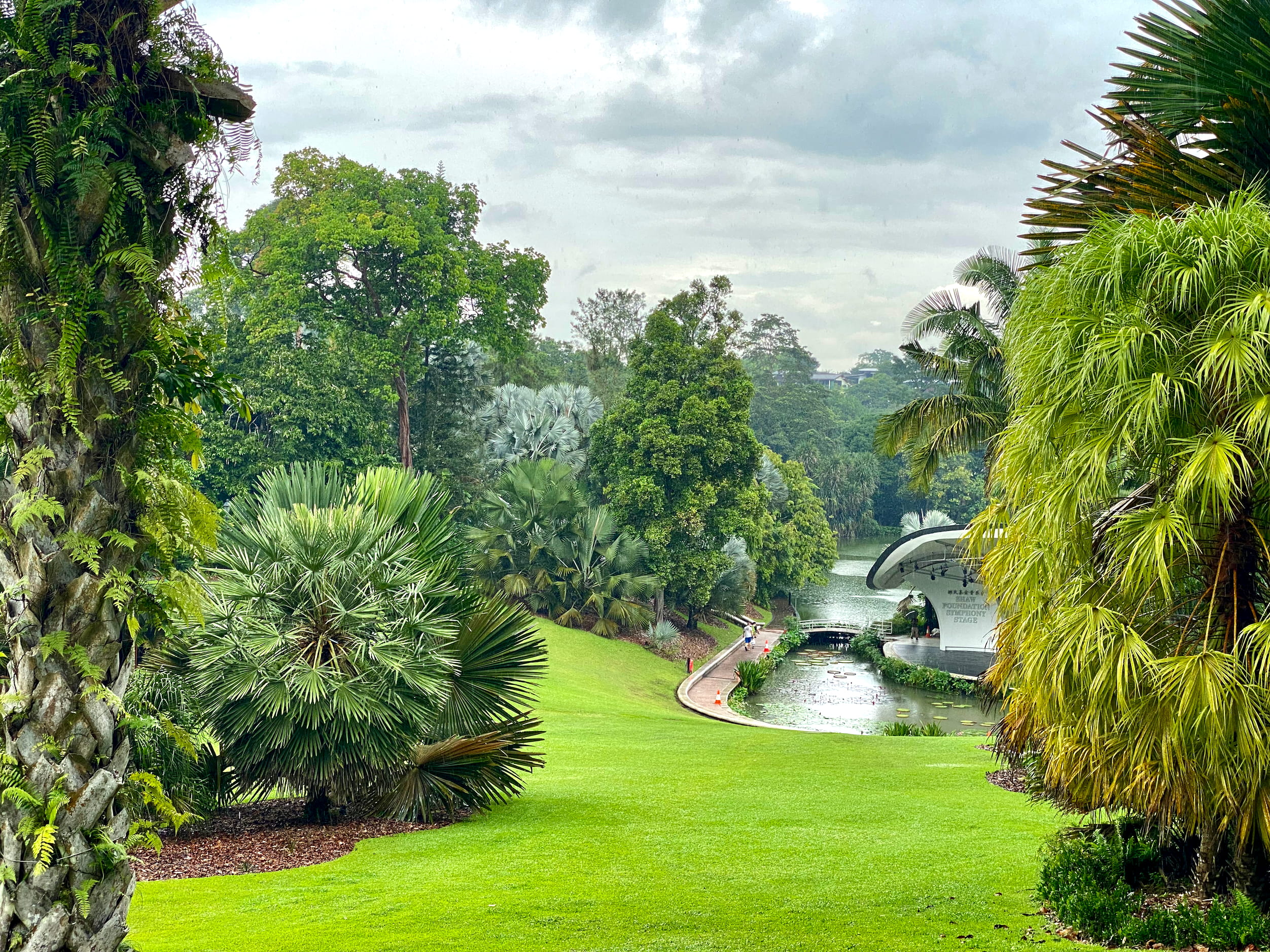
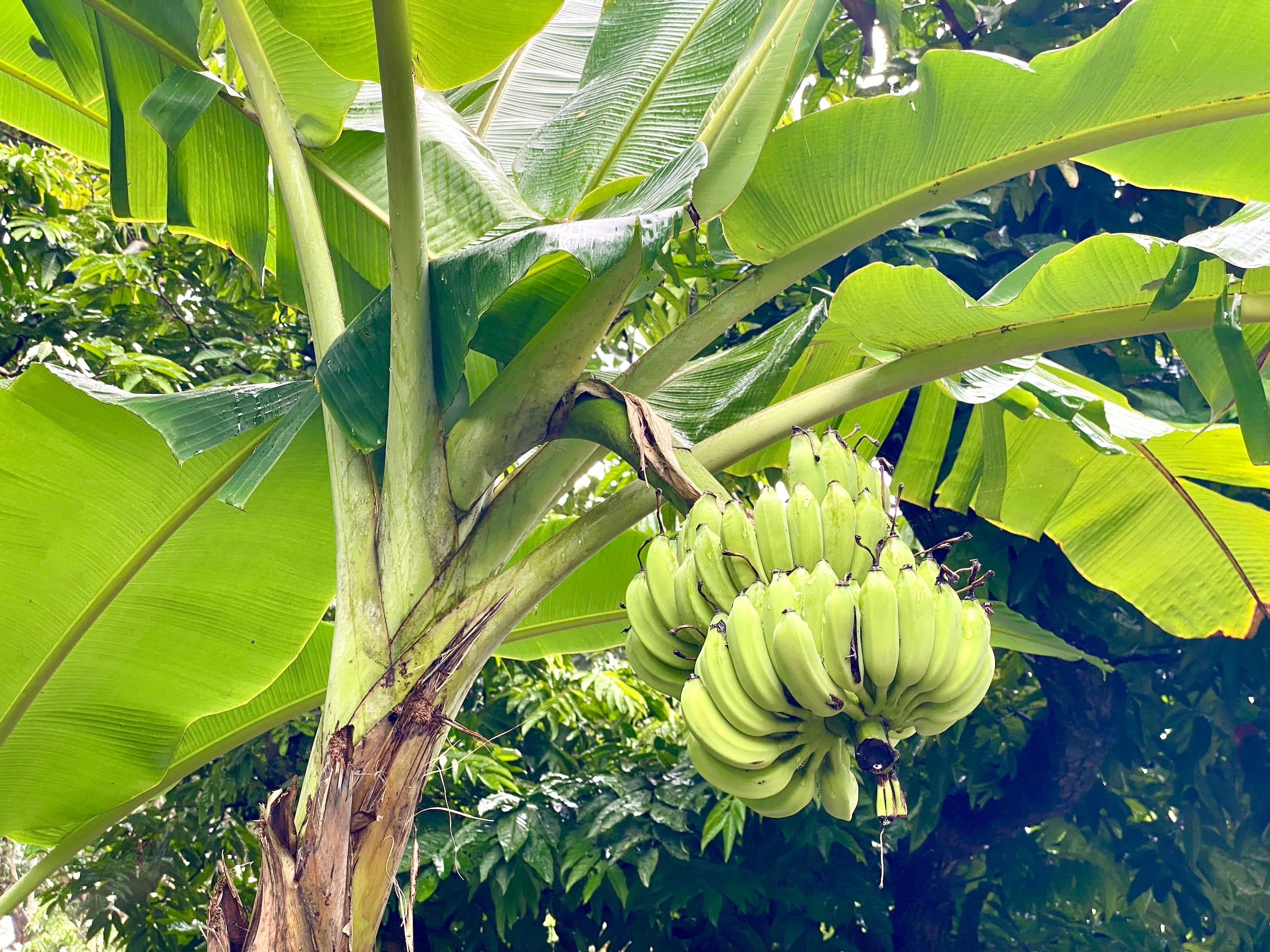
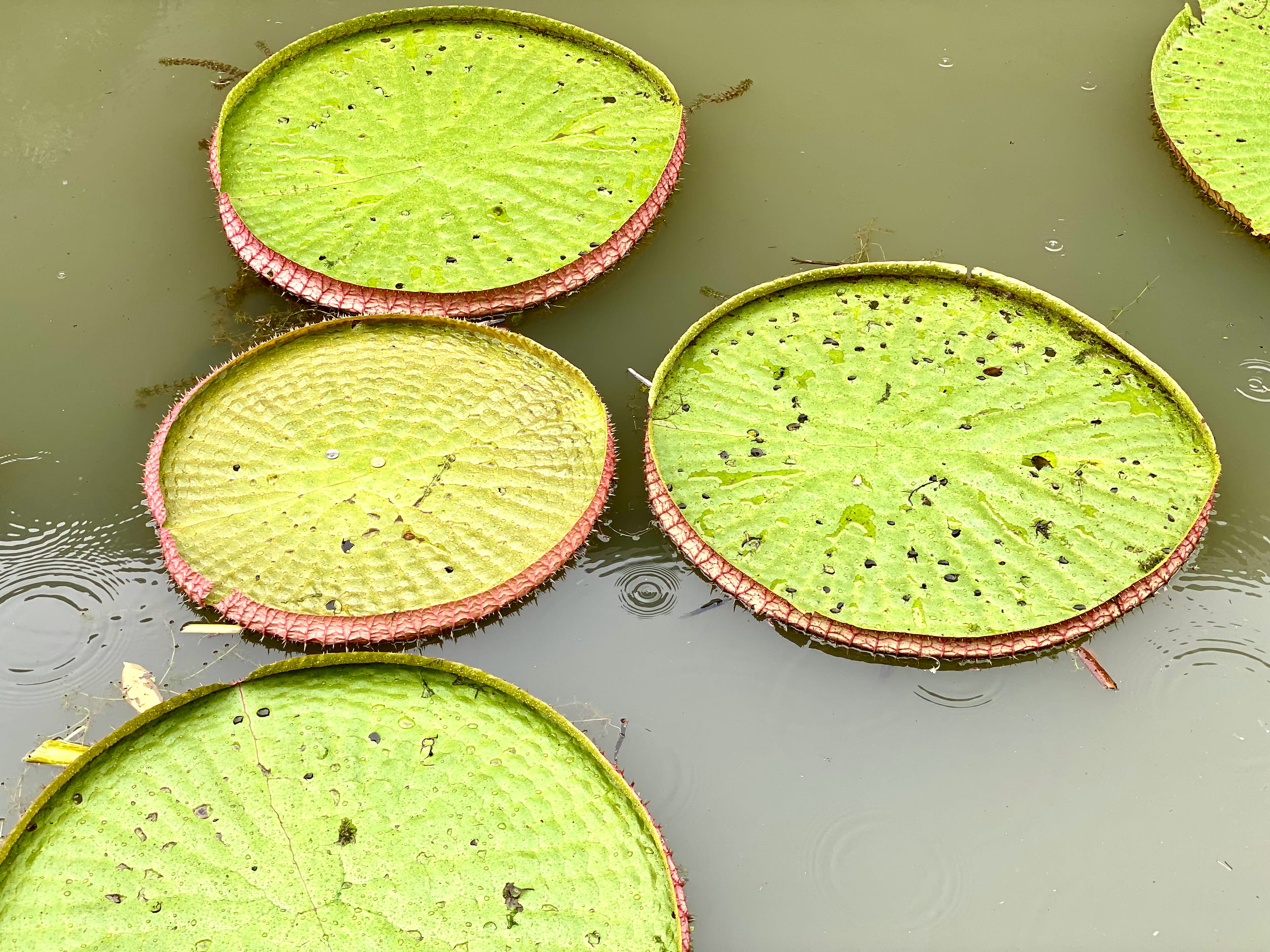
It rained the whole time, but was still pleasant, but this does mean the lighting is pretty meh for all the photos. Sorry.
The orchid garden inside is not free, and exhibits one of our recurring gripes that citizens get cheaper prices on everything than outsiders.
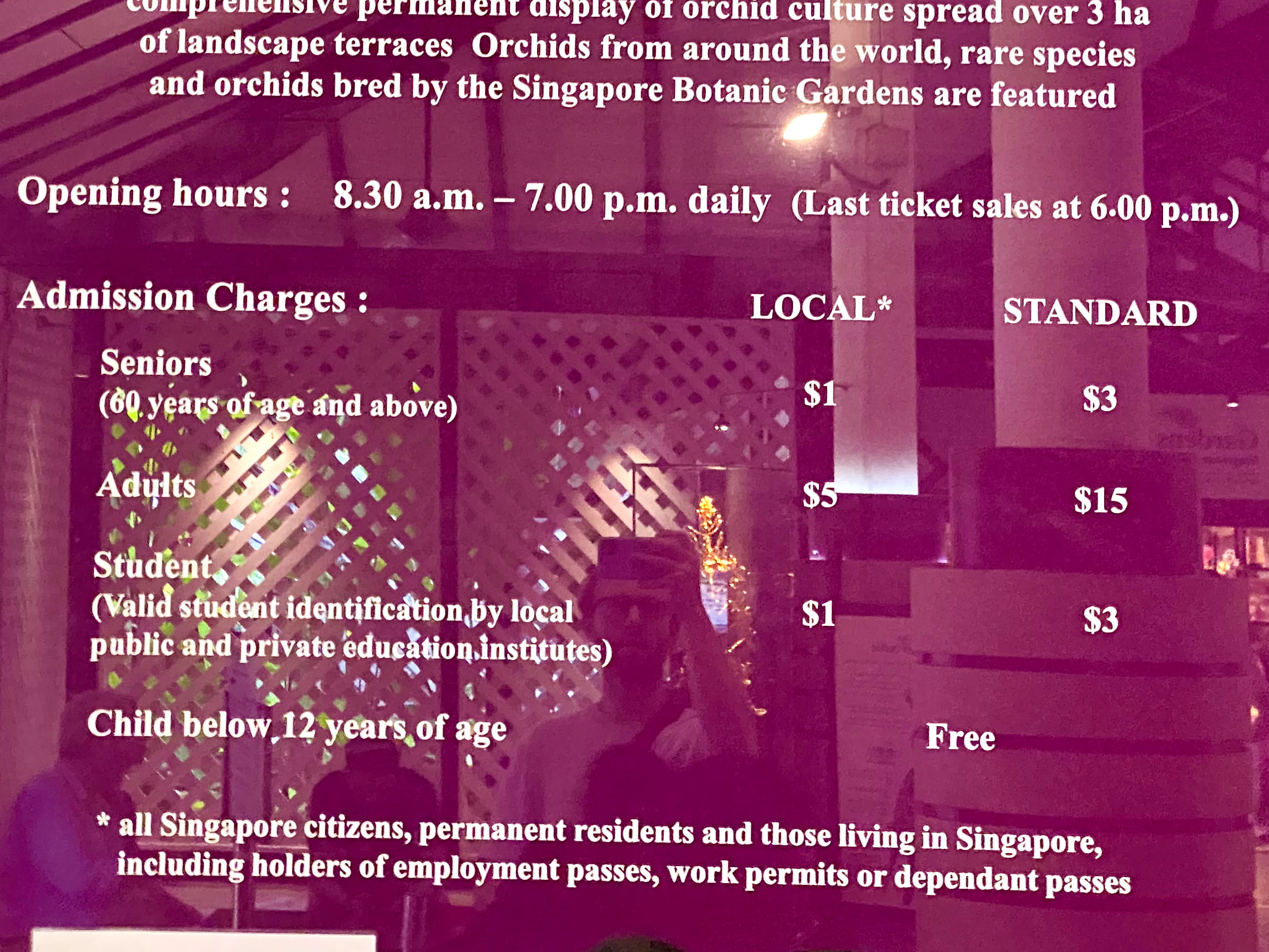
I actually like this policy in general. I wish more countries did it. But I think it makes the most sense to balance prices and make sites accessible for locals in lower-income countries. Not, uh, Singapore.
There were also both high-tech and cute design touches around, like automated bag drop machines at the airport, this indoor cycling track in a mall, and a children’s play area above plants.
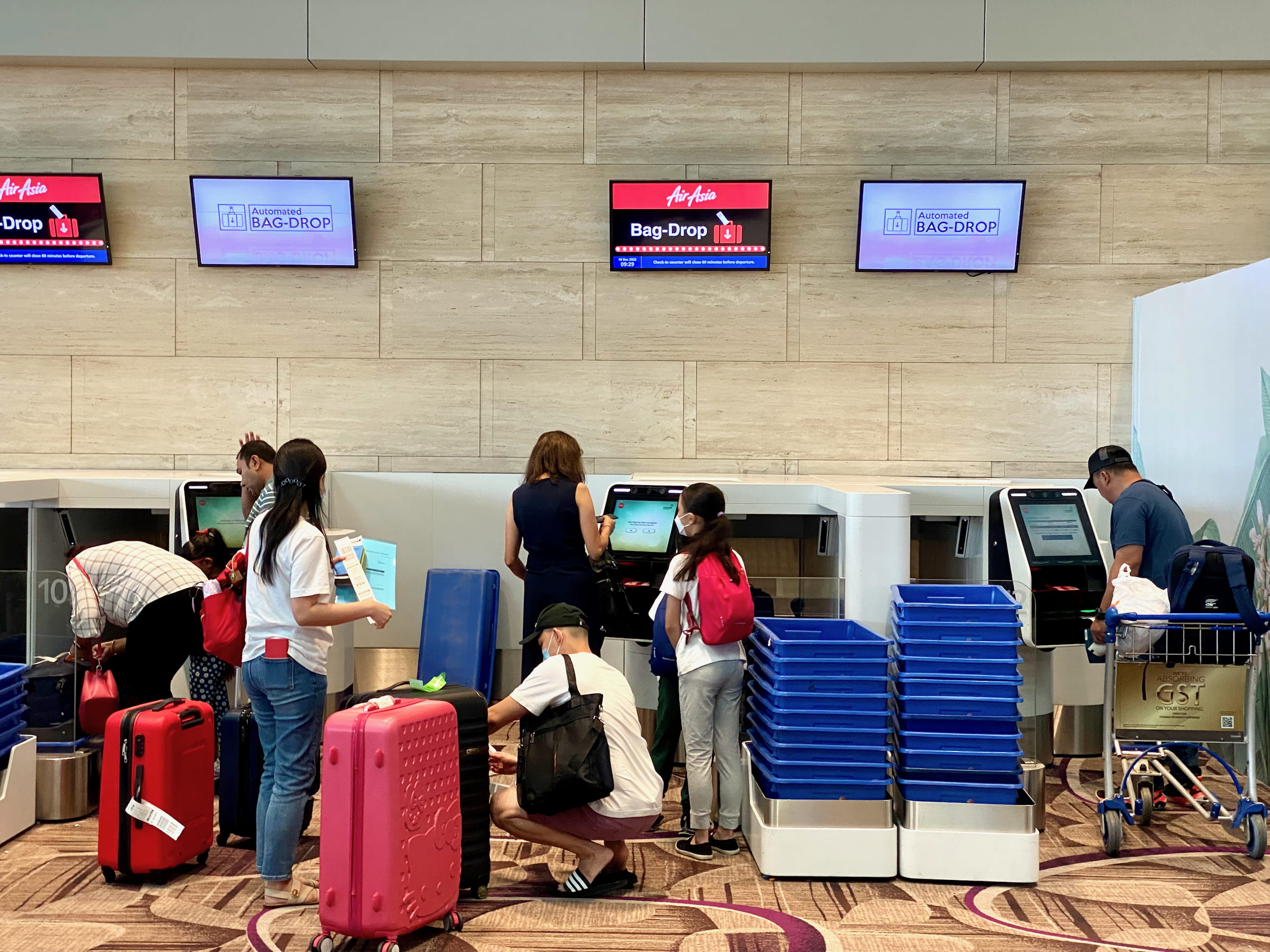
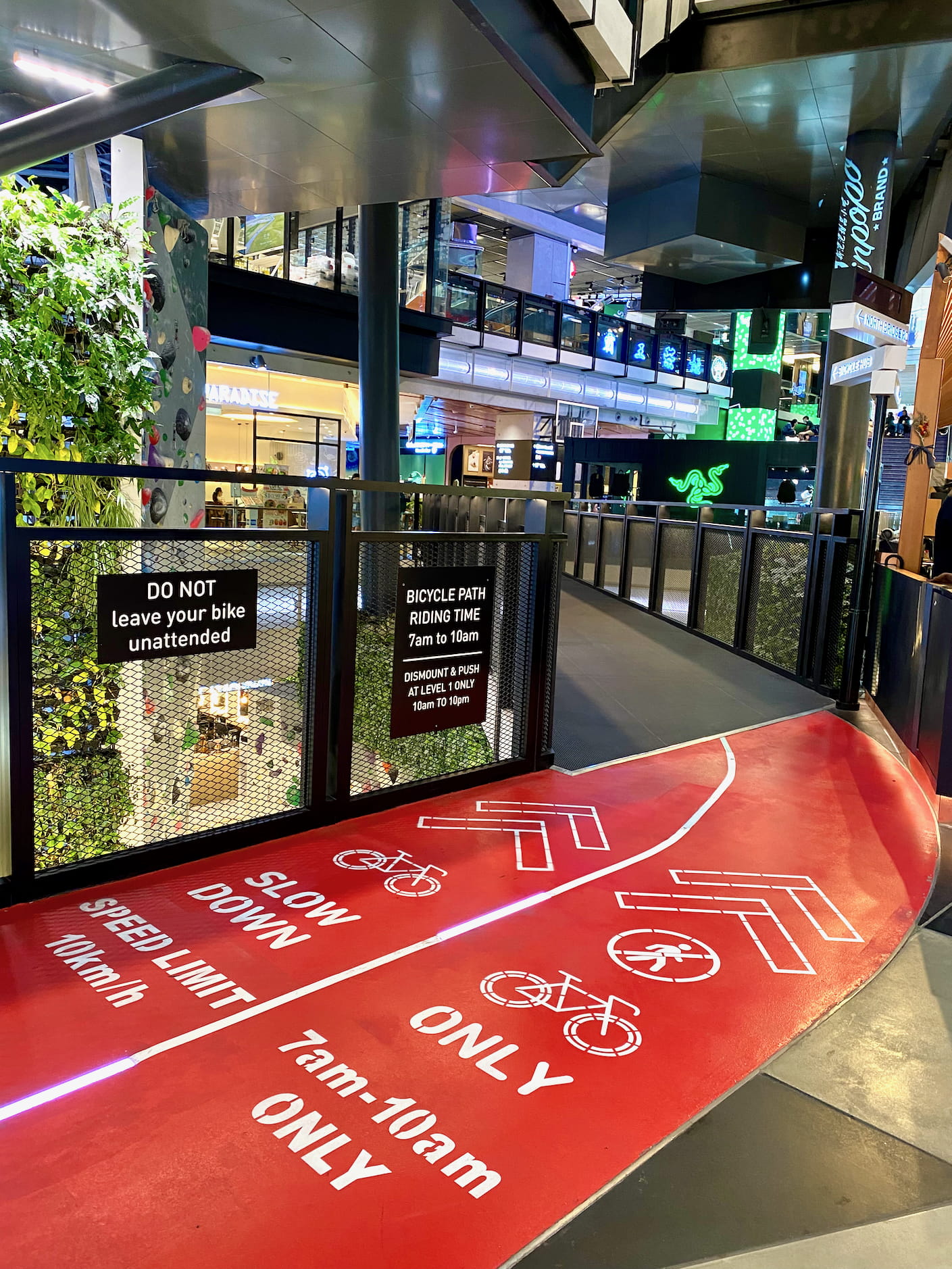
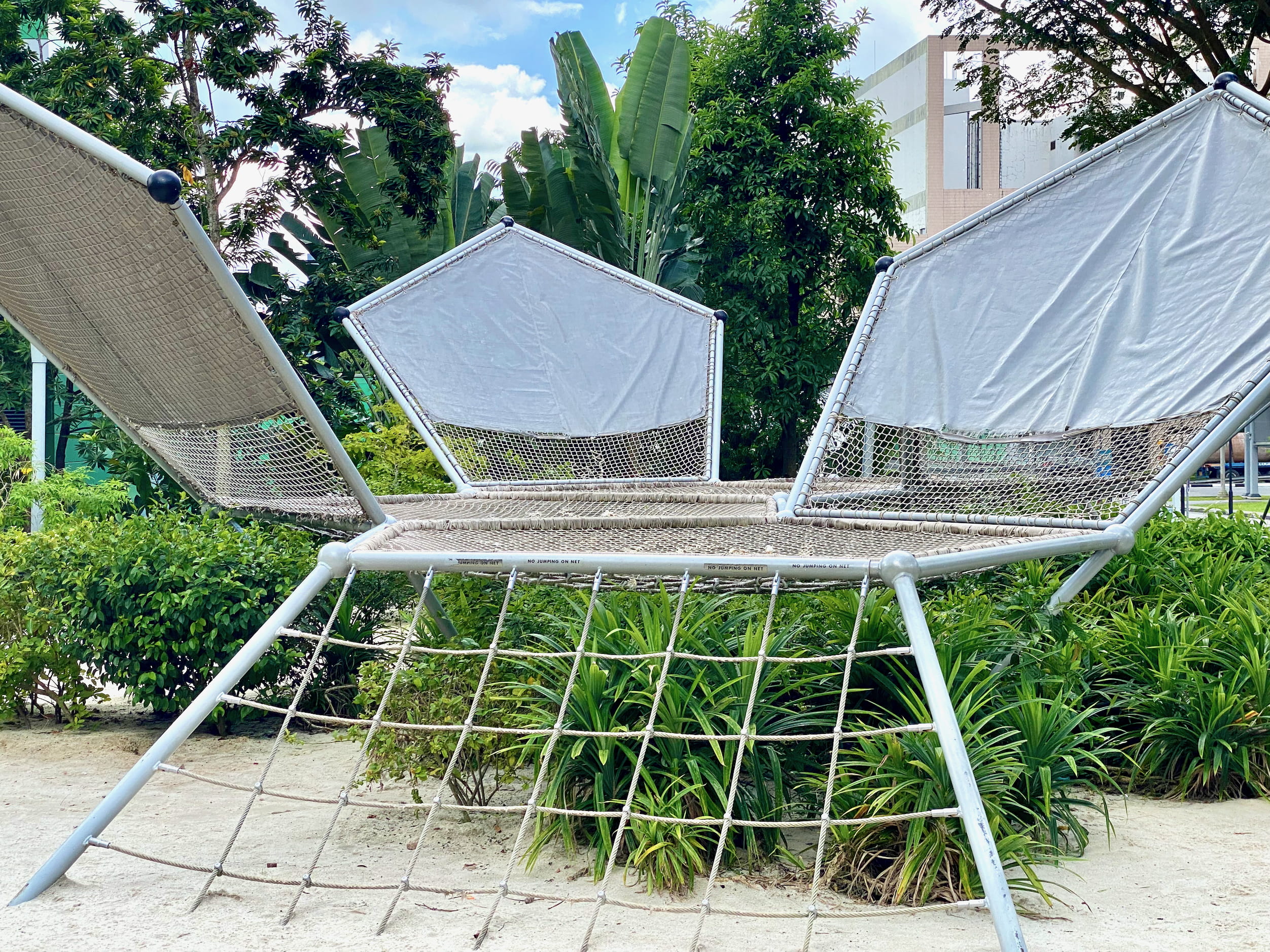
But with all this, I couldn’t help think about something I noticed right when landing in Singapore, which I’ll call eco aesthetics.
Eco Aesthetics
Before Singapore, we’d spent the last month in Vietnam and The Philippines. Both of those countries had what I’d call a get things done mode of business. Gas moped? Cheap and does the job. Plastic wrap? Effective. Products and services felt directly tied to people’s needs.
So it really stuck out when, right after landing, we head to Jewel (airport mall) for food, and store after store is advertizing how environmentally friendly their products are. This bag, this water bottle, these pants—you can feel good about them, because they’re good for the environment. These products are all brand-new, all expensive, and all shipped from overseas. They sat in pristine shelves in an air conditioned luxury mall.
It hit me because I hadn’t seen anything advertised as eco friendly for a month. Suddenly seeing all this stuff branded as eco friendly, it became so obvious that the environmental angle wasn’t just marketing, it was only marketing.
In case it’s not obvious, were’s why: buying shit is not eco friendly. What’s eco friendly is reusing a cheap old plastic container that will last a million years anyway. Wearing worn-out clothes and patching them. Valuing utility over newness, function over trends.
I had read before about eco friendliness being a marketing tactic so that consumers get good feeling when they buy. But because I also worry about the environment, I’d never really seen through the veil. If I’m going to buy stuff, isn’t it good that I’m buying eco friendly stuff? It’s because I hadn’t really, honestly considered the that backdrop of the practice of buying things was optional. It took not buying anything besides food for many months (the whole no room in the suitcase thing) and then being in places where eco friendliness wasn’t an advertised or sought-after luxury to really see this for what it was.
Please don’t take this as preaching. I will probably return to my full desired level of consumerism as soon as I have the physical space and income to do so. By pure happenstance, this is relatively minimal, but that’s just because I’m a dork who doesn’t care about clothes and is otherwise relatively frugal. But don’t give me any points for resisting the draw of the purchasing machine. I’m as much a cog as anyone else.
All I’m claiming is that, with the right context, it is possible to, thoroughly and fully, see the eco friendly tag for what it is. An aesthetic.08
Once I saw this lens, I noticed it in more ways throughout Singapore. For example, an increasing number of buildings had plants growing on them, which made them feel eco-friendly somehow.
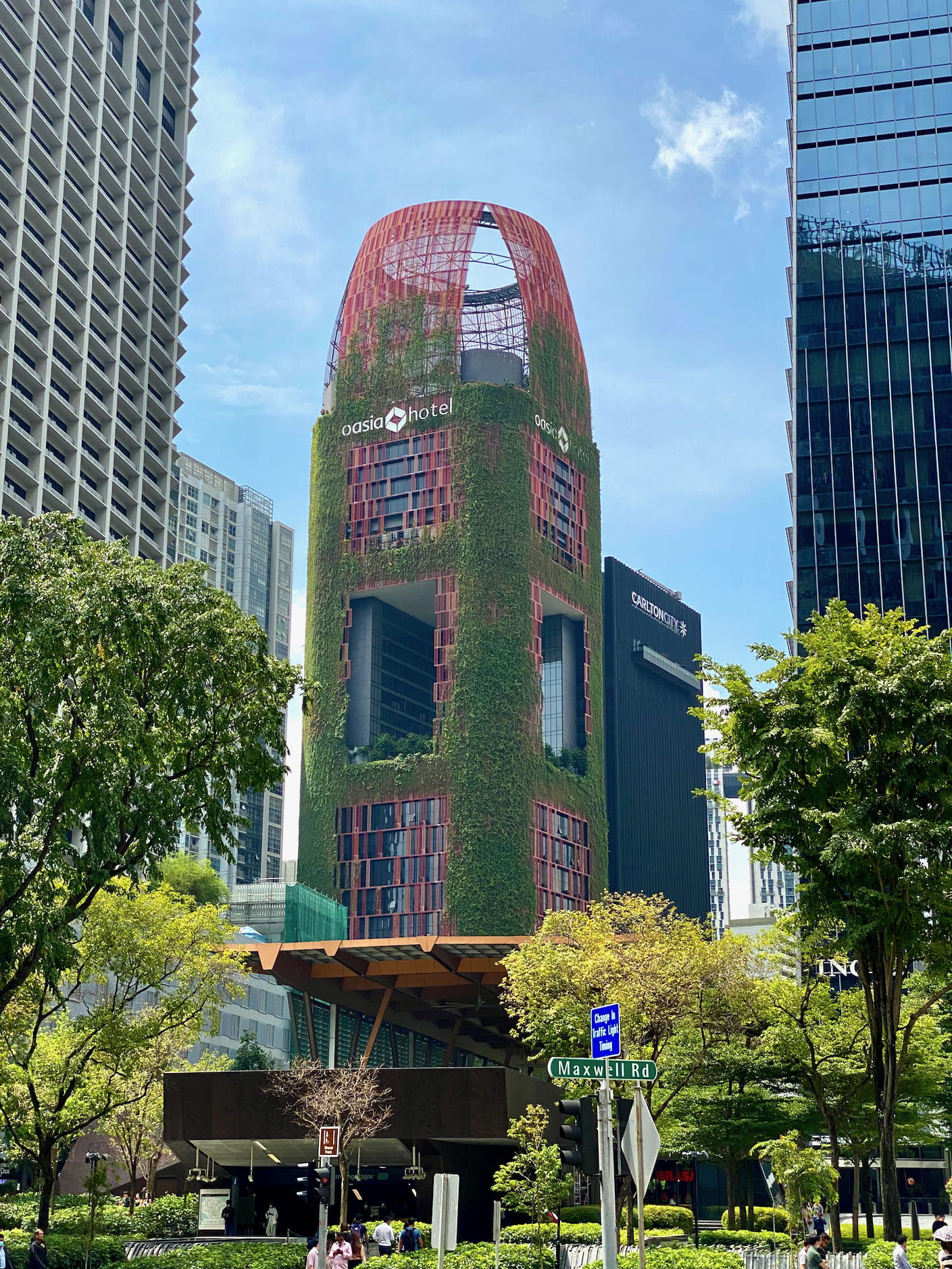
It’s a cool aesthetic, but like, those plants aren’t actually doing anything.
Another way was in the advertised eco friendliness of the city itself. In the urban design museum, they brag about how innovative they are on the environmental friendliness front by doing stuff like burning their poop—sorry, waste-to-energy incineration. But then if you look at how the country actually fuels its energy needs, it’s just 95% burning natural gas.
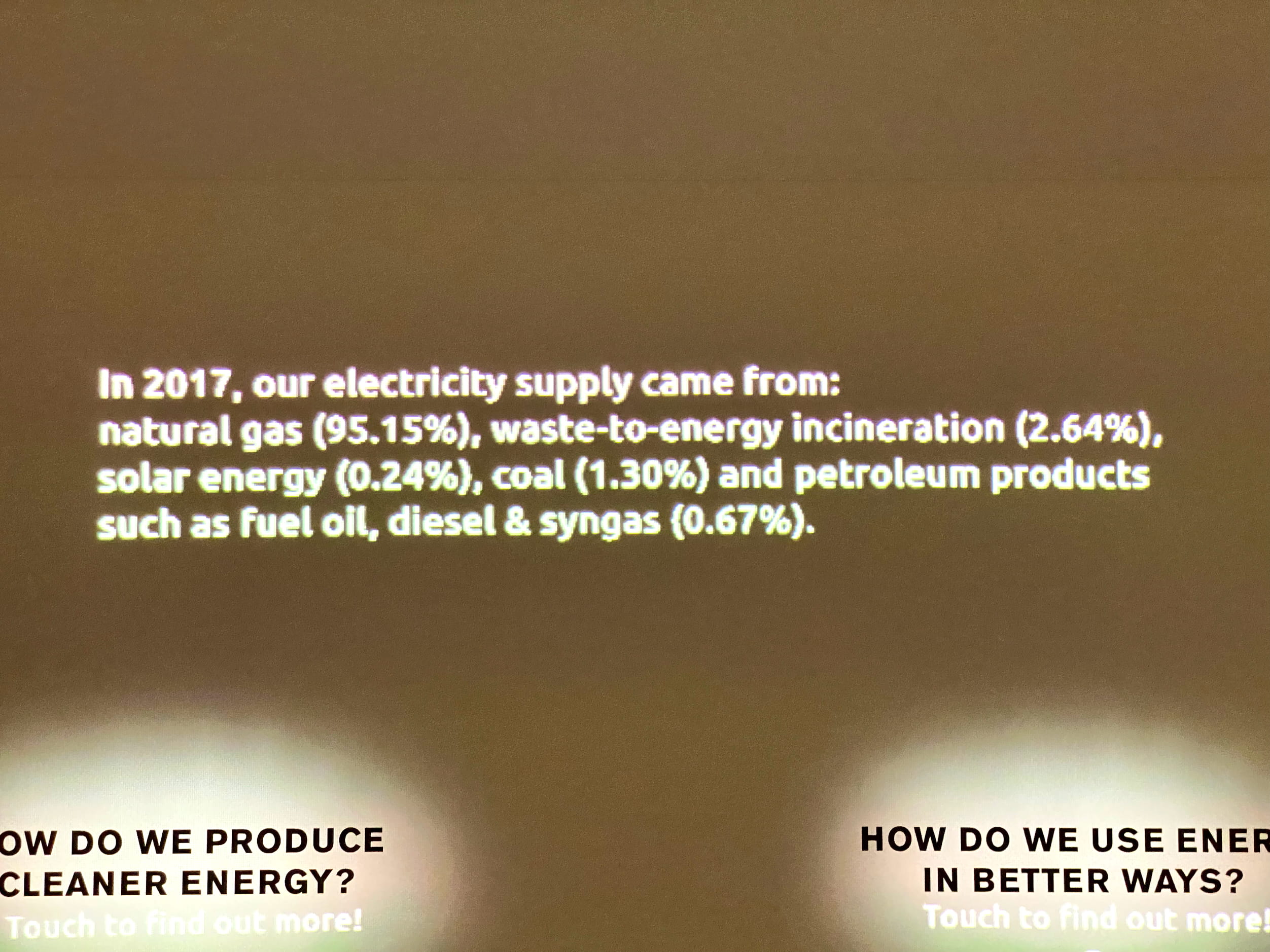
This kind of thing really hit home that, oh, it’s not that Singapore’s environmentally conscious and that made them successful somehow.09 It’s that they are extraordinarily wealthy, which lets them buy huge amounts of natural gas, and then do cool stuff with it, like air condition enormous glass domes so it’s slightly more pleasant inside them.
The eco friendly aesthetic thing isn’t anything specific to Singapore. It is surely present in every nation rich enough to have a free wheeling consumer class with environmental values. I just happened to first notice it in Singapore.
What is specific to Singapore is its narrative of itself as a tiny utopia. Could you resist feeling out the edges? I certainly can’t.
The Elephant in the Room
I actually went back and forth a lot about whether to write this section at all. Singapore fined someone $100,000 for sharing a Facebook link, without comment, that they did not like.10 Numerous other examples exist for people who have actually written negative things deemed inappropriate.11
So, let’s start slowly and ease our way in. For a high level overview, I asked ChatGPT to summarize Singapore’s issues, and it came up with the following five points.
Some criticisms of Singapore’s government system include:
Lack of political freedom: Singapore has strict laws limiting freedom of speech, assembly, and the press, leading to criticism from human rights organizations.
Authoritarianism: The People’s Action Party (PAP), which has been in power since 1959, has been accused of suppressing opposition voices and limiting political competition.
Lack of transparency: The government has been criticized for a lack of transparency in decision-making, particularly in areas such as financial investments and government procurement.
Income inequality: Despite Singapore’s prosperity, income inequality has been a growing concern, with a significant percentage of the population struggling to make ends meet.
Housing costs: Housing prices in Singapore are some of the highest in the world, leading to concerns about affordability and the availability of affordable housing.
From personal experience, the first thing I noticed is that there are a wild number of specific rules posted all around. Anecdotally, they are not shy about enforcing them.
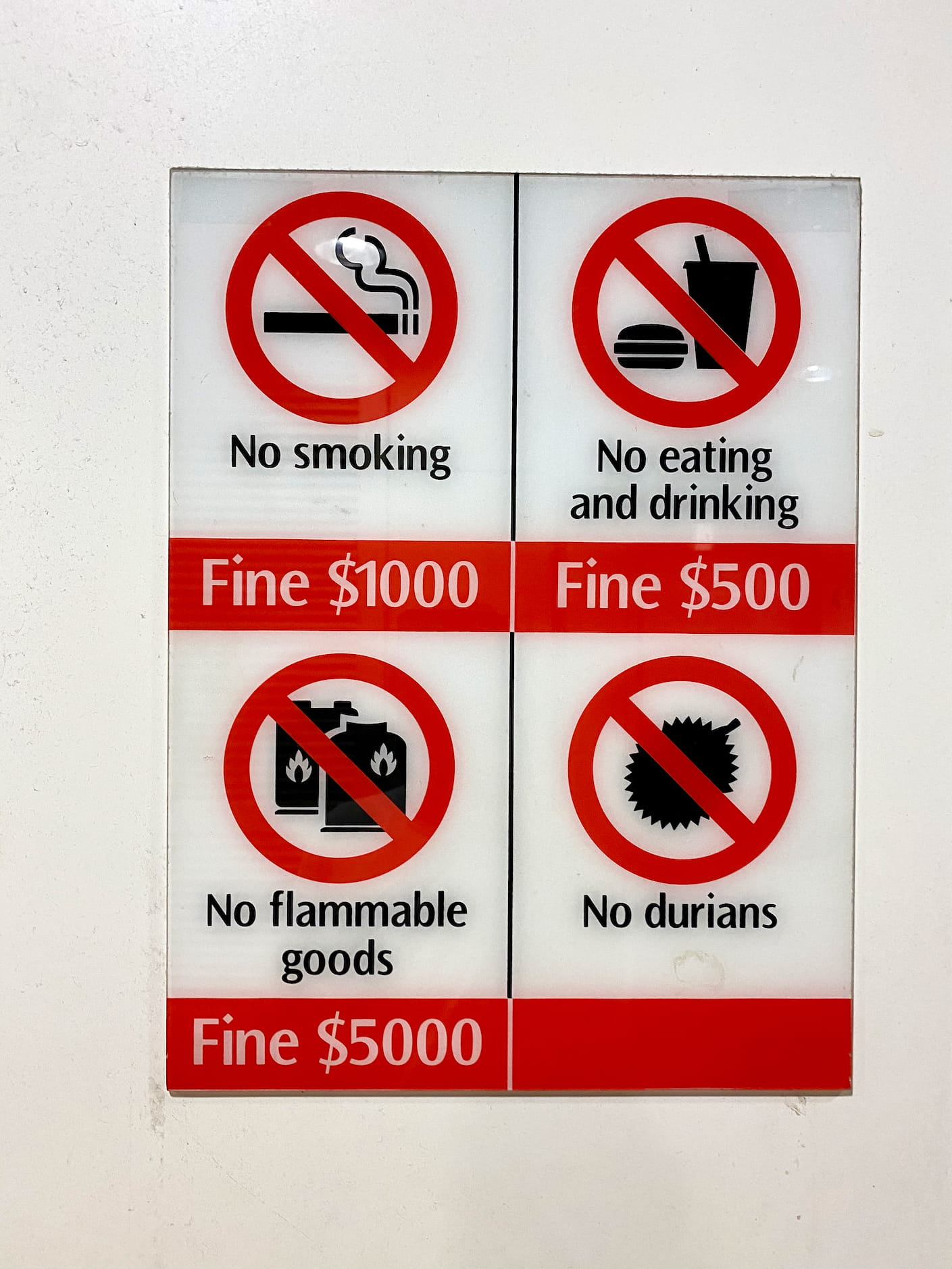
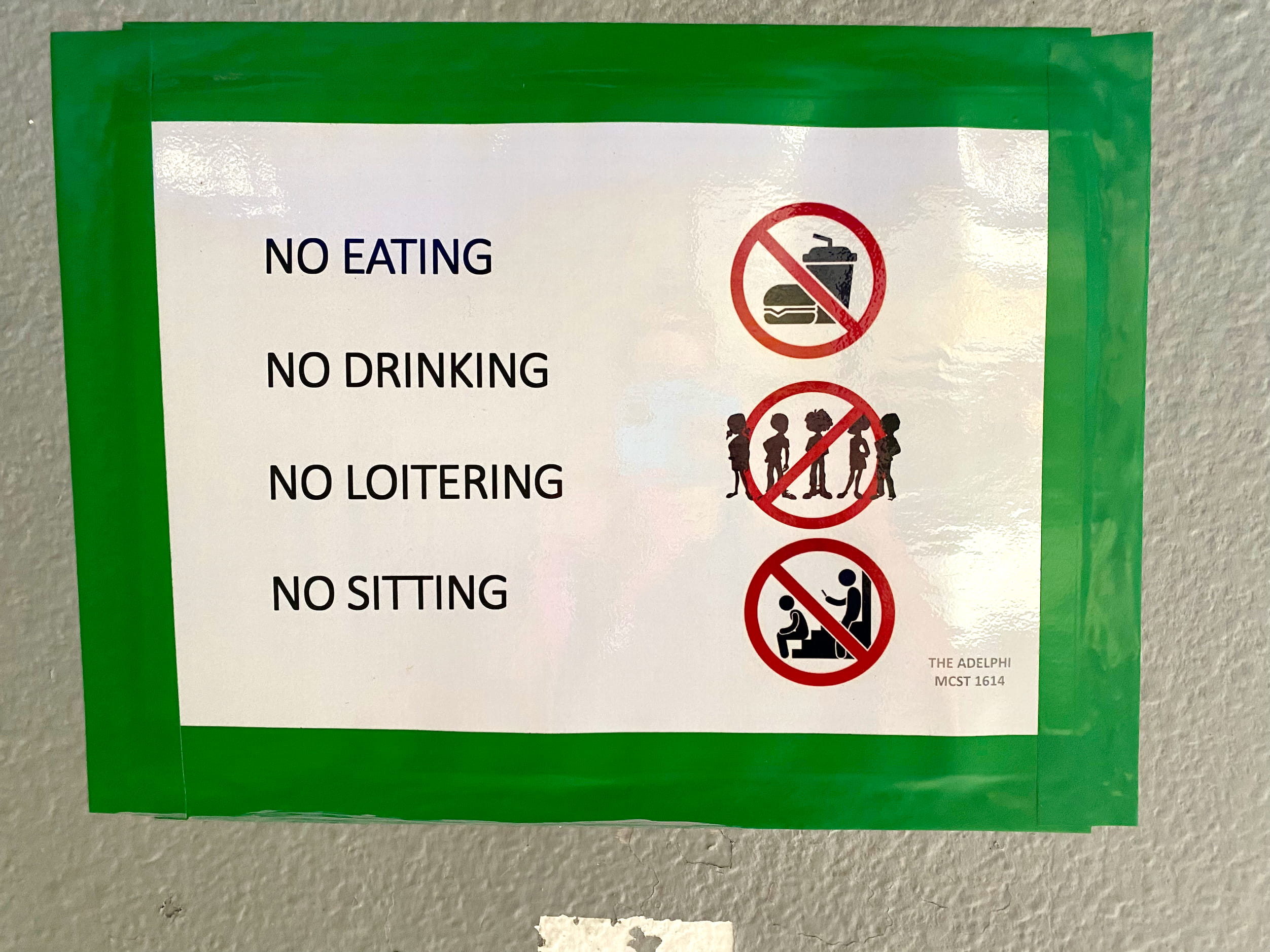
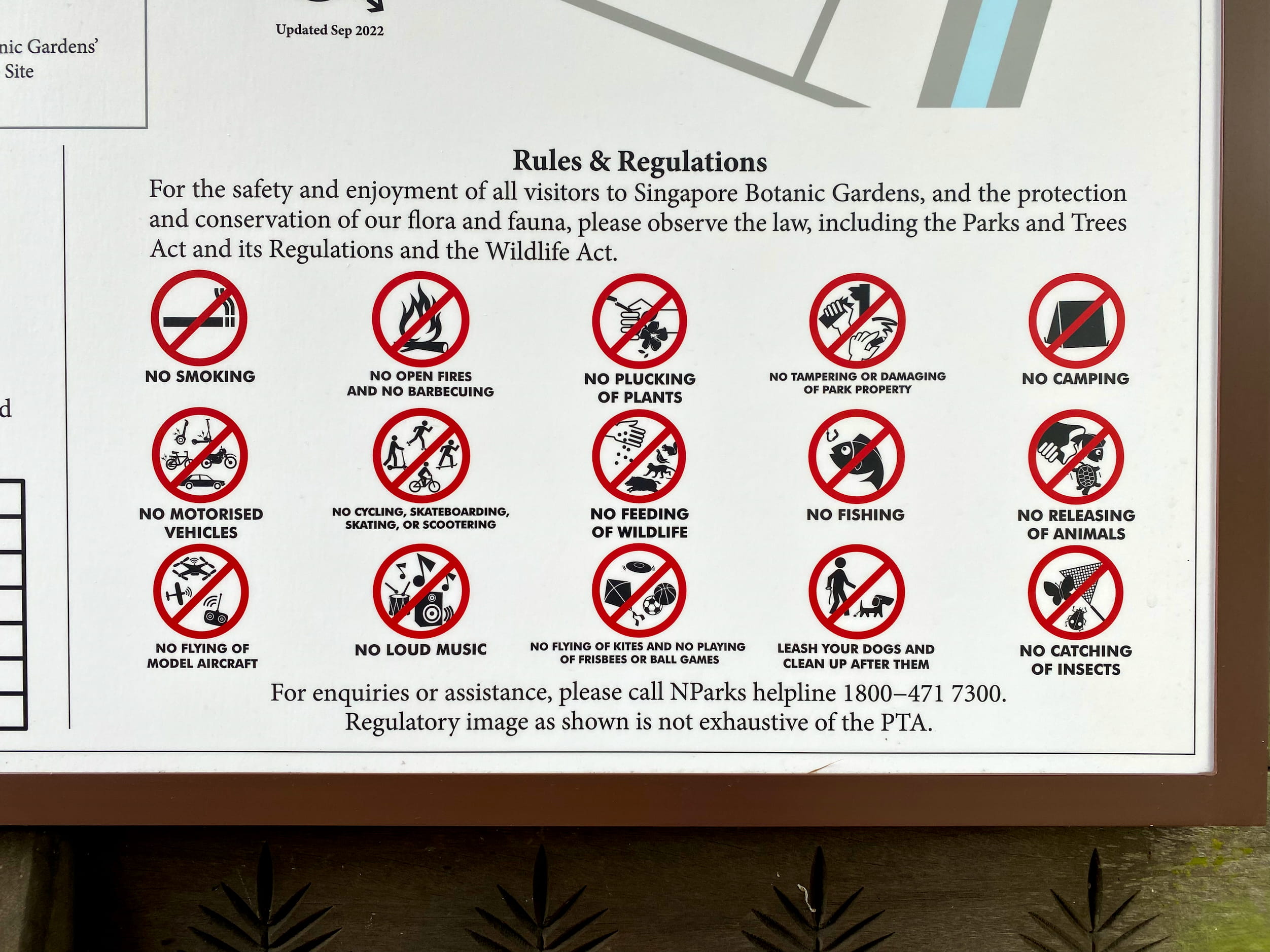
I was sad to find out, after seeing several signs referencing the PTA, that it’s not Pain in The Ass, but Parks and Trees Act.
Singapore’s most publicized atypical measures of control are:
- Chewing gum — illegal to import and sell since '92
- Drugs = death — signs all over the airport inform you that the death penalty is mandatory if you try to bring in drugs
- Caning — the beatings continue until moral improves12
The issues I was more interested in were those about migrant workers. It’s extremely common to a live-in maid or two who handle all the cooking, cleaning, nannying, etc. Workers are brought in from surrounding poor countries to fulfill these roles, as well as handle manual labor jobs that Singaporeans don’t want. The biggest problem I read about is that they’re kept in limbo, rather than being integrated into the country:
This creates a lifelong temporariness with no prospects of settling in the country where they work.
…
Migrant workers are tied to a single employer–– often without a written contract––limiting job mobility while working under the constant threat of termination.
…
Singaporean government-controlled media promote the notion of happy workers to reassure the public that Singapore provides adequate systems and safety nets for migrant workers.
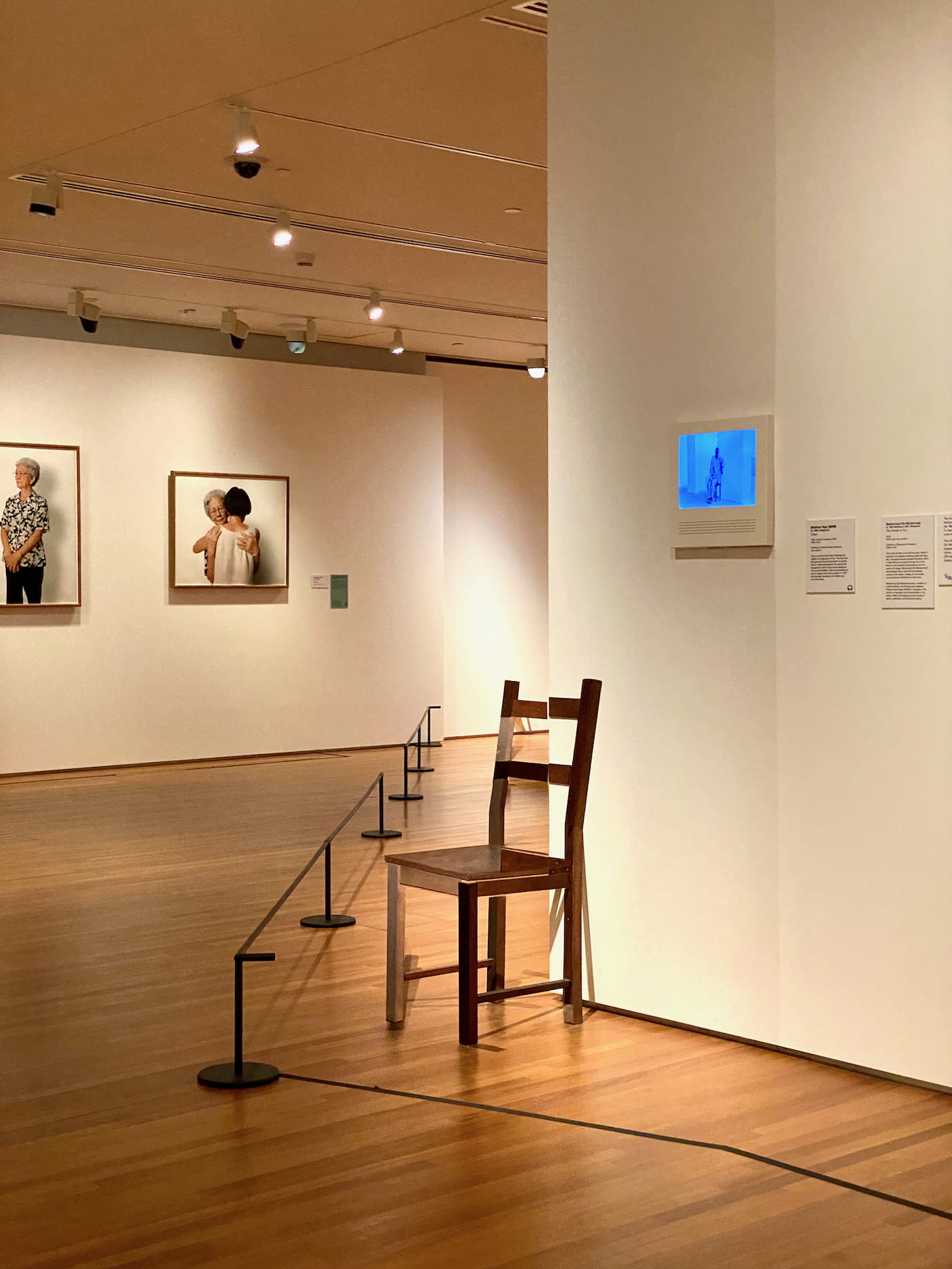
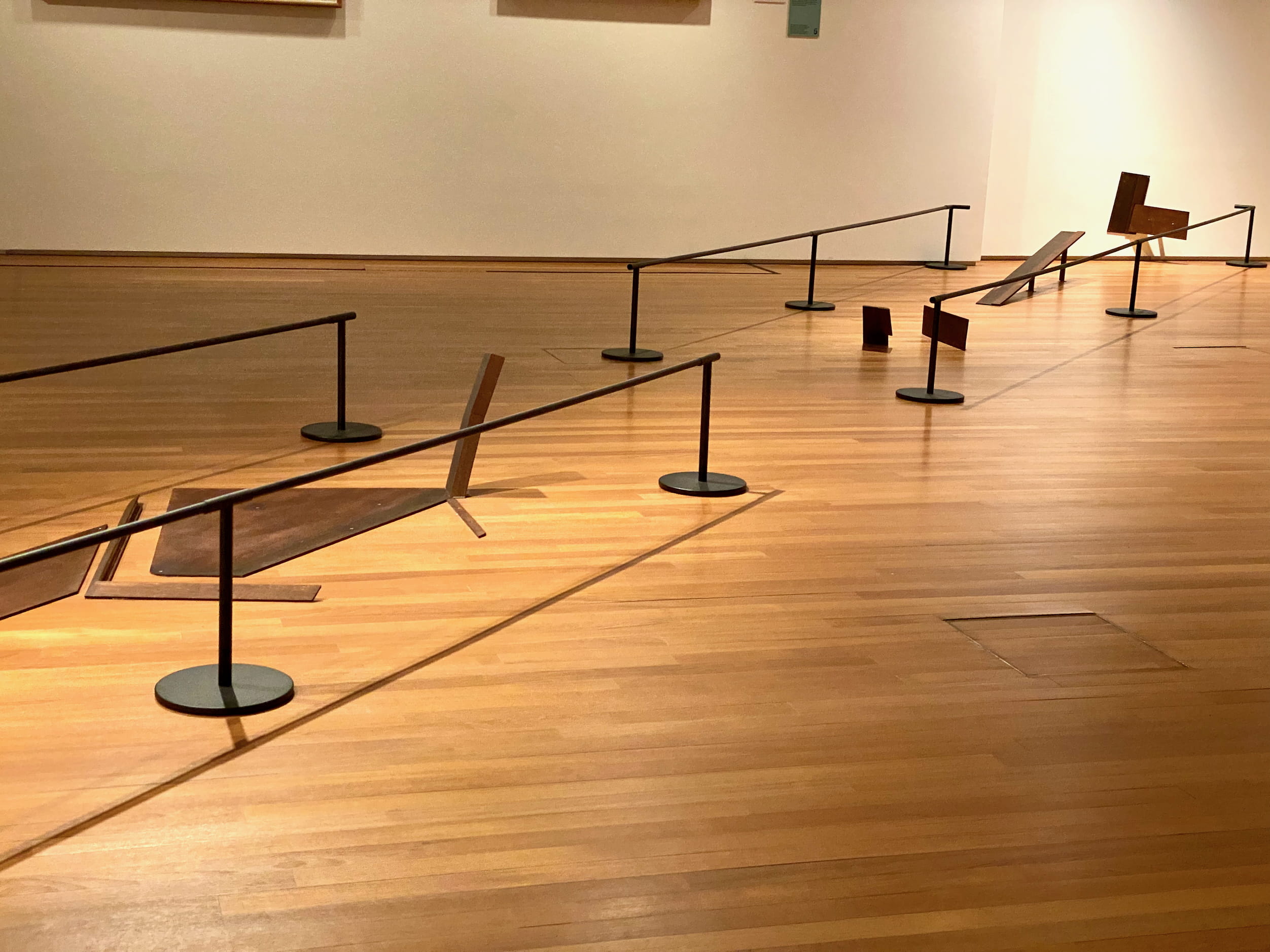
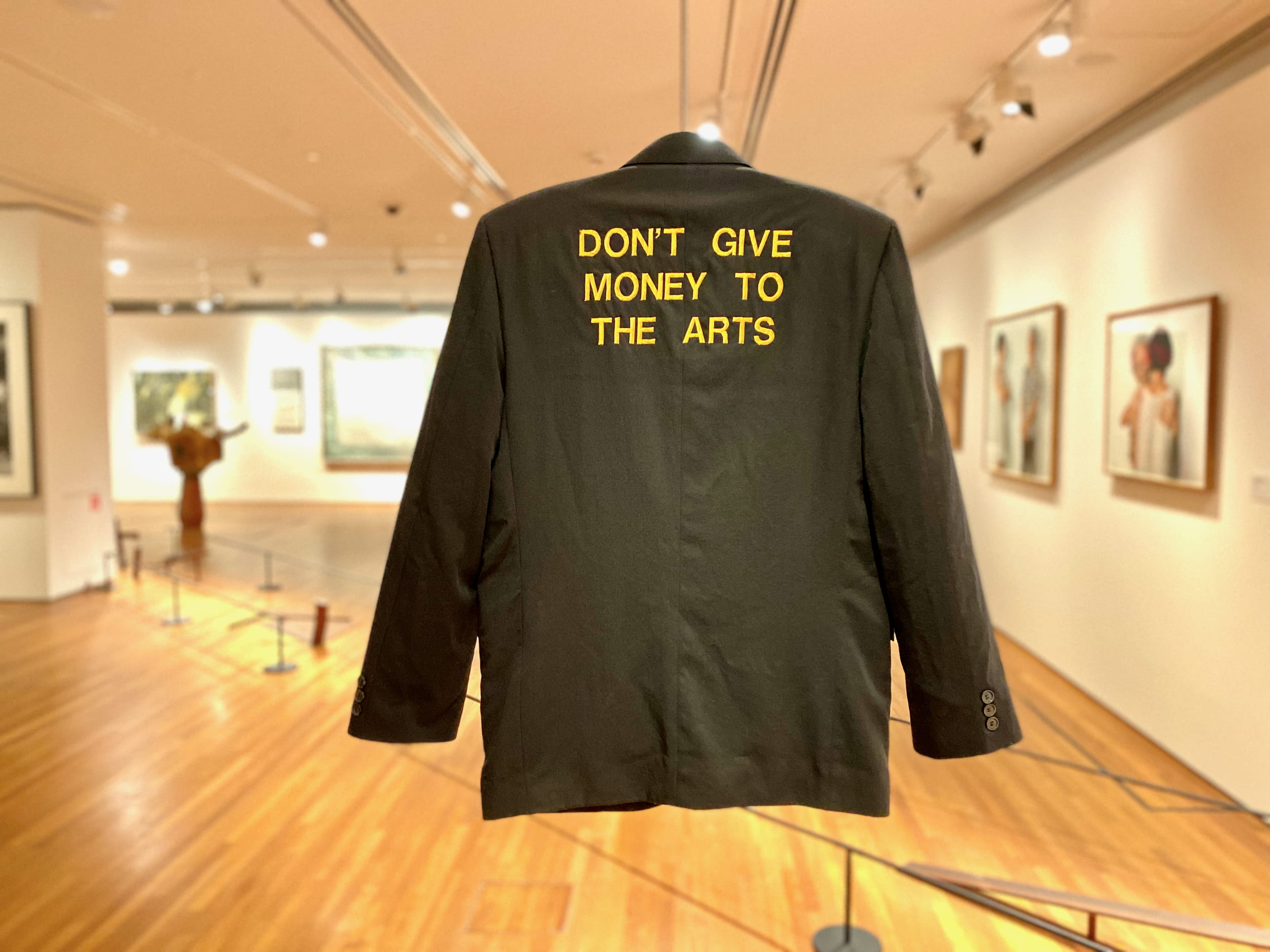
Pieces from the National Gallery were often pleasant but sanitary (above, a chair’s optical illusion), or ever so delicately mentioning the government’s unenthusaism for the arts, e.g., Tang Da Wu’s 1995 jacket from the period when performance art was illegal.
But the best piece of criticism I’ve seen written about Singapore is William Gibson’s (the scifi author) 1993 essay for Wired magazine, Disneyland with the Death Penalty.13 Quoth Wikipedia: “The Singapore government responded to the publication of the article by banning Wired from the country.”14
Eerily, it could describe Singapore as perfectly today as it did thirty years ago.
Singapore is a relentlessly G-rated experience, micromanaged by a state that has the look and feel of a very large corporation… There’s a certain white-shirted constraint, an absolute humorlessness in the way Singapore Ltd. operates; conformity here is the prime directive, and the fuzzier brands of creativity are in extremely short supply.
…
There is less in the way of alternative, let alone dissident style in Singapore than in any city I have ever visited… A thorough scan of available tapes and CDs confirmed a pop diet of such profound middle-of-the-road blandness that one could easily imagine the stock had been vetted by Mormon missionaries.
…
Concerned that a series of earlier campaigns to reduce the national birth rate had proven entirely too successful, Singapore has instituted a system of “mandatory mixers.” I didn’t find this particularly disturbing, under the circumstances, though I disliked the idea that refusal to participate is said to result in a “call” to one’s employer. But there did seem to be a certain eugenic angle in effect, as mandatory dating for fast-track yuppies seemed to be handled by one government agency, while another dealt with the less educated.
— William Gibson, Disneyland With the Death Penalty, Wired Magazine, 1993
Writing all this, I have to point out that the USA’s problems are almost certainly worse. We have our lion share of issues exploiting migrant workers who do jobs Americans are unwilling to do, private prisons, deeply entrenched racism, and waaay more corruption than Singapore.15 (This all aside from our global blunders, like, you know, installing dictators and jumping into wars all over the world.) Probably the one thing the USA’s government does significantly better than Singapore’s is, to be clichéd, freedom: having actual political freedom, freedom of speech, assembly, arts, and so on.
I point this out because my aim isn’t to compare countries and declare a winner. Rather, because Singapore seems like such a utopia on the surface, and its state media talks about itself as such a utopia, it becomes all the more interesting to find the ways in which it’s not. What it sacrifices to build the society it has.16
Ultimately, my many solitary musings about Singapore are just another instance of my musings about expression and censorship as the 21st century plays out. Musings that frequently find its way to China’s cultural stranglehold, Europe’s fervent privacy defenses, and the USA’s own ham-fisted balancing of mass surveillance, misinformation, freedom of speech, and the arts. Watching this era become the great proving ground for methods of government surviving the transition into the digital age. A two sentence excerpt from Gibson summed up why it feels like a big deal: “Myself, I’m inclined to think that if they prove to be right, what will really be proven will be something very sad; and not about Singapore, but about our species. They will have proven it possible to flourish through the active repression of free expression.”
Footnotes
Bangladesh, the Philippines, Sri Lanka, and so on. ↩︎
Like iPhone, they stylize it without a “The” before it. ↩︎
If you want to get depressed about the USA’s recent track record on public projects, check out something like Why America Can’t Build. ↩︎
I remember a quote from someone, I believe a politician in China, saying that if they only had to manage something the size of Singapore, they could do a great job as well. I can’t find the quote though, even with GPT-4’s help :-( ↩︎
~$100k fees imposed by the government as auto ownership deterrence, which seemed to just make them more desirable as high class objects. ↩︎
I’d contrast it to any major city—NYC, London, Tokyo, Seoul, Taipei—where the subway feels like the urban lifeblood for most residents. ↩︎
The whole UNESCO label has always somewhat baffled me—what around the world gets it and why—but that’s a digression for another time. ↩︎
The same experiences also made me believe that approaches to large scale environmentalism should provide individual benefits to work. For example, nobody rides the trillions of gas mopeds in Hanoi because people love gas. (I mean, some real motor-heads do, but let’s set the enthusiasts aside.) They do it because a gas moped is the cheapest and most widely available way to get around. If electric mopeds were cheaper to buy and operate, everyone would ride them. In other words, making things environmentally friendly needs to be the best choice financially for people to do it. You can’t rely on the upper middle class in a handful of liberal cities to flush their toilet every other time and buy Lululemon’s sustainable yoga pants to stop Amsterdam from becoming Atlantis. It seems like government policies and subsidies are probably the mechanism for this. ↩︎
I mean, obviously that’s not true when you think about it, but subliminally, that’s the kind of message that I think starts to seep in. ↩︎
Specifically the prime minister himself sued the guy for defamation, and won. Keep in mind, this guy didn’t write the article, just posted a link on Facebook that stayed up for three days. ↩︎
I mean, yeah, I’ll be fine outside the country. The issue is if I ever want to pop by for another visit. ↩︎
This one is interesting to me. After reading the quote, “If the penalty for a crime is a fine, then that law only exists for the poor,” I thought, huh, maybe there is a perverse beauty to caning as punishment. There’s a lot of gory details here, if you’re curious. My main question was: how hard? Quoth the source: “The caning officer is required to exert as much strength as he can muster for each stroke… They are trained to use their entire body weight as the power behind every stroke instead of using only the strength from their arms, as well as [sic] to induce as much pain as possible.” ↩︎
The article is still on Wired. It’s paywalled here, if you subscribe to them. Here’s a version from their website before it was paywalled. ↩︎
If you check out the Corruption Perceptions Index, Singapore ranks 4th best in the world, while the USA is at 27th. ↩︎
I also haven’t touched on Singapore’s whole origin story, building itself from a humble port to financial hub and limited utopia that it is, in a pretty short time span (since the '60s). ↩︎
